Posts Tagged by matt anderson
Remembering Lee Iacocca, 1924-2019
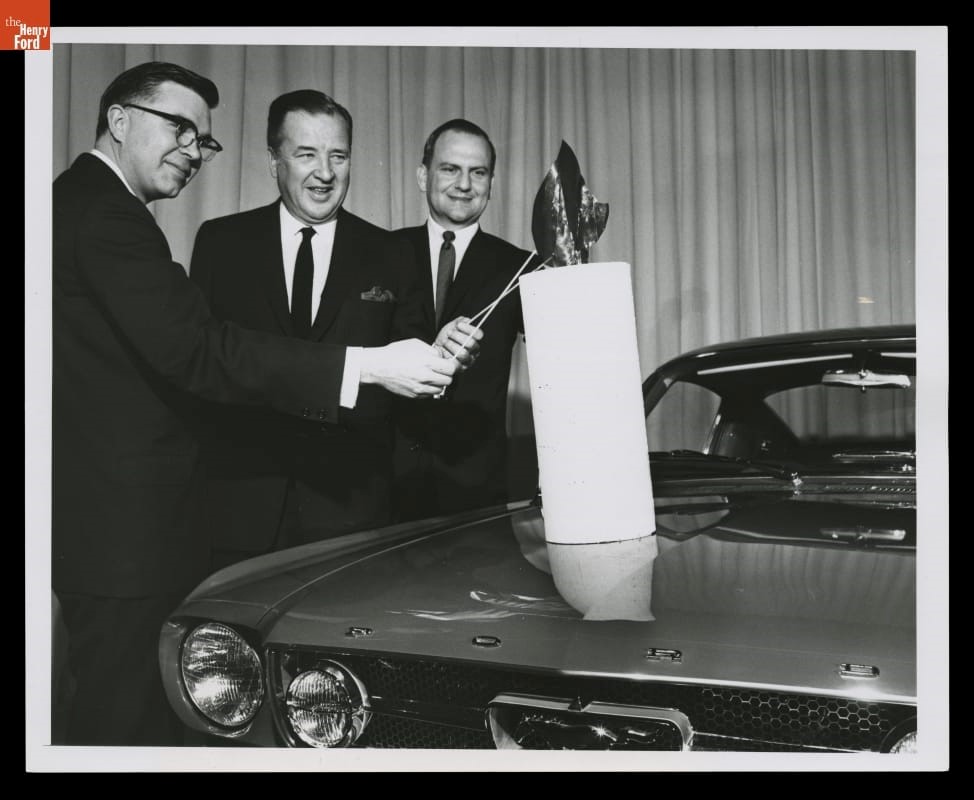
Lee Iacocca (right) lights a candle with Henry Ford II (center) and Don Frey to celebrate the Ford Mustang’s first birthday in April 1965. (THF113838)
A Born Salesman
Lee Iacocca, the charismatic corporate executive whose long careers at Ford and Chrysler made him one of the best-known businessmen in America, passed away on July 2 at age 94. With his passing, the automotive industry lost one of its most colorful figures of the last 60 years.
Born and raised in Allentown, Penn., Iacocca earned a degree in industrial engineering from Lehigh University in 1945. Given his location, one might have expected him to take a job in the steel industry. But Iacocca was one of those people with gasoline in the veins. He wanted to build cars – specifically, he wanted to build them for Ford Motor Company. He joined the Blue Oval in 1946 as an engineer. But for a born salesman like Iacocca, it was an awkward fit at best. He asked for a reassignment to sales in Ford’s Philadelphia district, and his career blossomed from there.
Iacocca first attracted attention from senior Ford managers with a novel promotion in the mid-1950s. He dreamed up a “’56 for 56” gimmick in which customers could buy a new 1956 Ford with 20 percent down and monthly payments of $56 thereafter. It was simple, it was catchy, and it was a hit. The promotion earned him a transfer to Ford’s world headquarters in Dearborn.
Total Performance
Lee Iacocca made no small plans. Barely into his 30s when he moved to Dearborn, Iacocca resolved that he’d be a Ford vice president by age 35. Though he climbed up the ranks quickly, he missed his goal – Iacocca wasn’t named Vice President and General Manager of the Ford Division until he’d turned 36. By a twist of fate, Ford President Robert McNamara left to become President Kennedy’s Secretary of Defense soon after Iacocca’s appointment. Iacocca’s influence at Ford Motor Company increased accordingly.
Young, enthusiastic, and a car guy to the core, Iacocca was the polar opposite of McNamara, whose major accomplishments at Ford included turning the sensuous two-seat Thunderbird into a four-seat family sedan. (Though to be fair, McNamara nearly doubled Thunderbird’s sales as a result.) Iacocca wanted his company to think young. He remembered the Ford V-8 of his own youth which, with help from legions of hot rodders, gave Ford a performance image. Chevrolet snatched that image in the mid-1950s with its small-block V-8 and its classic “Tri Five” Chevys of 1955-57.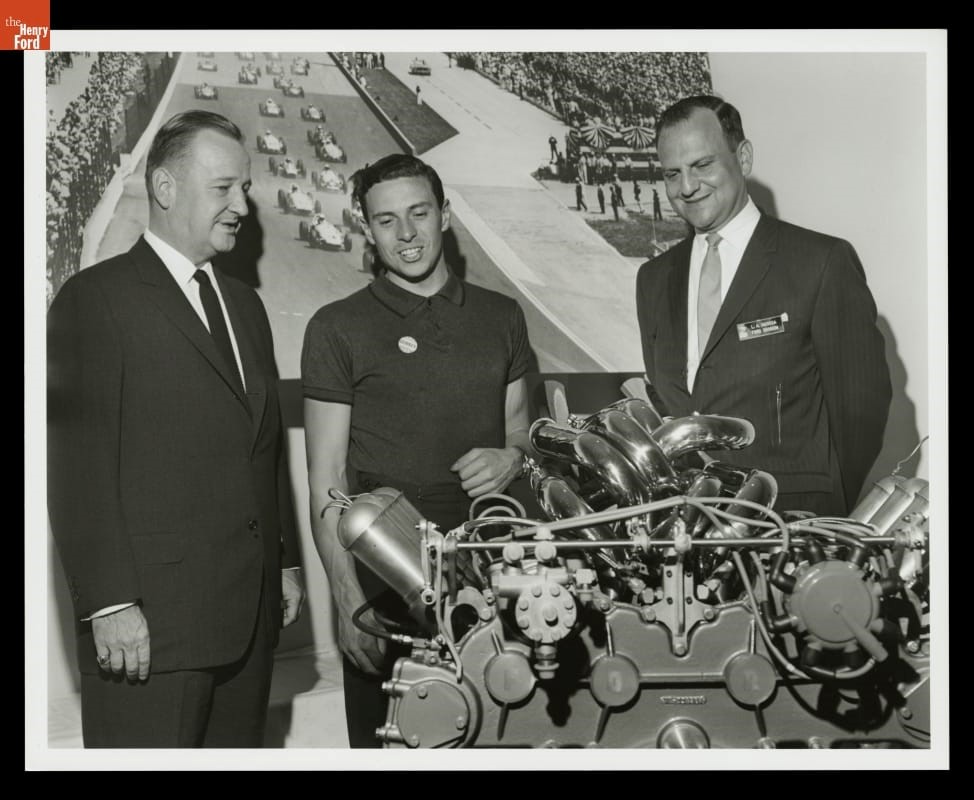
Iacocca (right) with Jimmy Clark (center), Benson Ford, and the double overhead cam V-8 that Ford developed for the Indianapolis 500. (THF110520)
Among Iacocca’s first moves were to get Ford Motor Company back into racing. He greenlit a striking mid-engine sports car prototype and then – with Henry Ford II, Leo Beebe, Carroll Shelby, Jacque Passino, and others – launched an all-out assault in nearly every form of racing under the banner “Total Performance.” By decade’s end, Ford had racked up victories in NASCAR, on drag strips, at Indianapolis, and at Le Mans. But Iacocca’s tenure at Ford is forever tied to one car.
The Youth Car
Working in secret with a select team, Iacocca pitched the need for a “youth car” targeted at the up-and-coming Baby Boomers. He wanted something with the appeal of a Thunderbird, the look of a Ferrari, and the economy of a Volkswagen – a tall order to be sure. But Ford’s designers and engineers rose to the challenge. In one of the automotive industry’s great triumphs, they put a sporty body on the existing Ford Falcon compact car chassis, produced a seemingly endless menu of options and accessories that encouraged customers to personalize, and dubbed their new creation “Mustang” – a name that evoked freedom, open spaces, and, in the words of one marketing expert, “was American as all hell.”
Ford optimistically hoped to sell 200,000 Mustangs in the first model year. But the car’s splashy launch – at the 1964 New York World’s Fair – and a savvy marketing campaign kicked off a mania rarely seen in automotive showrooms. By the end of the 1965 model year, more than 680,000 buyers had taken a new Mustang home.
Mustang’s success made Iacocca a household name. But his rising star contributed to growing tensions between Iacocca and Henry Ford II, the company’s chairman and ultimate authority. After several difficult years, their strained relationship foundered and, in 1978, led to an acrimonious parting of the ways between Iacocca and Ford Motor Company.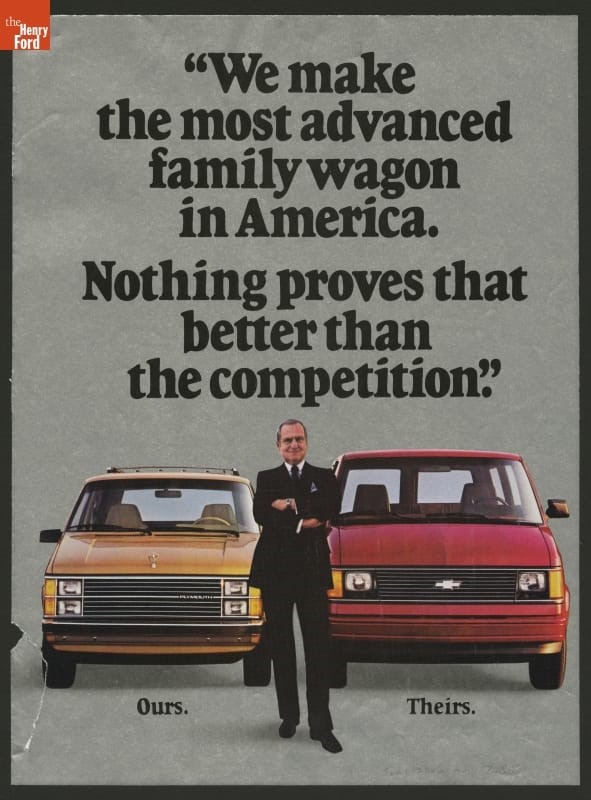
Iacocca found the perfect pitchman for Chrysler – himself. His print and television ads made him one of the best-known business figures in the United States. (THF103024)
A Second Act
No one could have blamed Iacocca if he’d retired then and there. The Mustang alone was enough to secure his legacy. But retirement wasn’t Iacocca’s style. He missed being at the center of the action. When the failing Chrysler Corporation offered him the job of CEO, he couldn’t resist. Iacocca’s second act was even more impressive than his first.
Iacocca took over a company in ruin. Chrysler was losing millions with little hope of recovery. His first and most important act was to secure a loan guarantee from the U.S. Congress. He then set about rebuilding the automaker’s product line. First came the K-Car, a highly-adaptable front-wheel drive platform that Chrysler offered under any number of makes, models and designs. Then came another vehicle that, like the Mustang before it, transformed the industry. The minivan, manifested in the Plymouth Voyager and the Dodge Caravan, was born of an idea Iacocca had toyed with at Ford to no avail. At Chrysler, the innovative minivan became a best-seller that redefined the family car for a generation of Americans. To top off his achievements, Iacocca added an evergreen marque to Chrysler’s lineup when he acquired American Motors and its enduring Jeep brand in 1987.
Eager to restore faith in Chrysler vehicles, Iacocca personally vouched for his products in a series of memorable television and print ads. He ended many of them with a simple, straightforward challenge to his audience: “If you can find a better car, buy it.” The ads were effective, and he enjoyed making them. In truth, he enjoyed the limelight. Through the 1980s, Iacocca added to his celebrity by writing two best-selling books, leading a successful effort to restore the Statue of Liberty, and appearing in a bit part on the popular TV series Miami Vice. For a time, there was even serious talk about Iacocca as a candidate for President of the United States.
Enough for Two Lifetimes
Iacocca retired from Chrysler in 1992. He’d returned the company to profitability, restored its reputation, and repaid its government loan. But even then he didn’t really retire. With billionaire Las Vegas developer Kirk Kerkorian, Iacocca launched an unsuccessful takeover attempt of Chrysler in 1995. Ten years later, he returned to Chrysler – by then under German ownership as DaimlerChrysler – to shoot a few commercials, reprising his trademark “If you can find a better car…” slogan.
Lee Iacocca seemed to live two lifetimes in his 94 years. He enjoyed success at two car companies, and he fathered two groundbreaking vehicles. Iacocca lived to see the Mustang turn 50, and to see Chrysler fall into bankruptcy once more before remerging as a part of FCA. He will be remembered as long as there are people who love cars like he did.
Matt Anderson is Curator of Transportation at The Henry Ford.
Pennsylvania, Dearborn, Michigan, 21st century, 20th century, racing, Mustangs, in memoriam, Ford workers, Ford Motor Company, cars, by Matt Anderson
Fabulous Fins Soar at Motor Muster in 2019
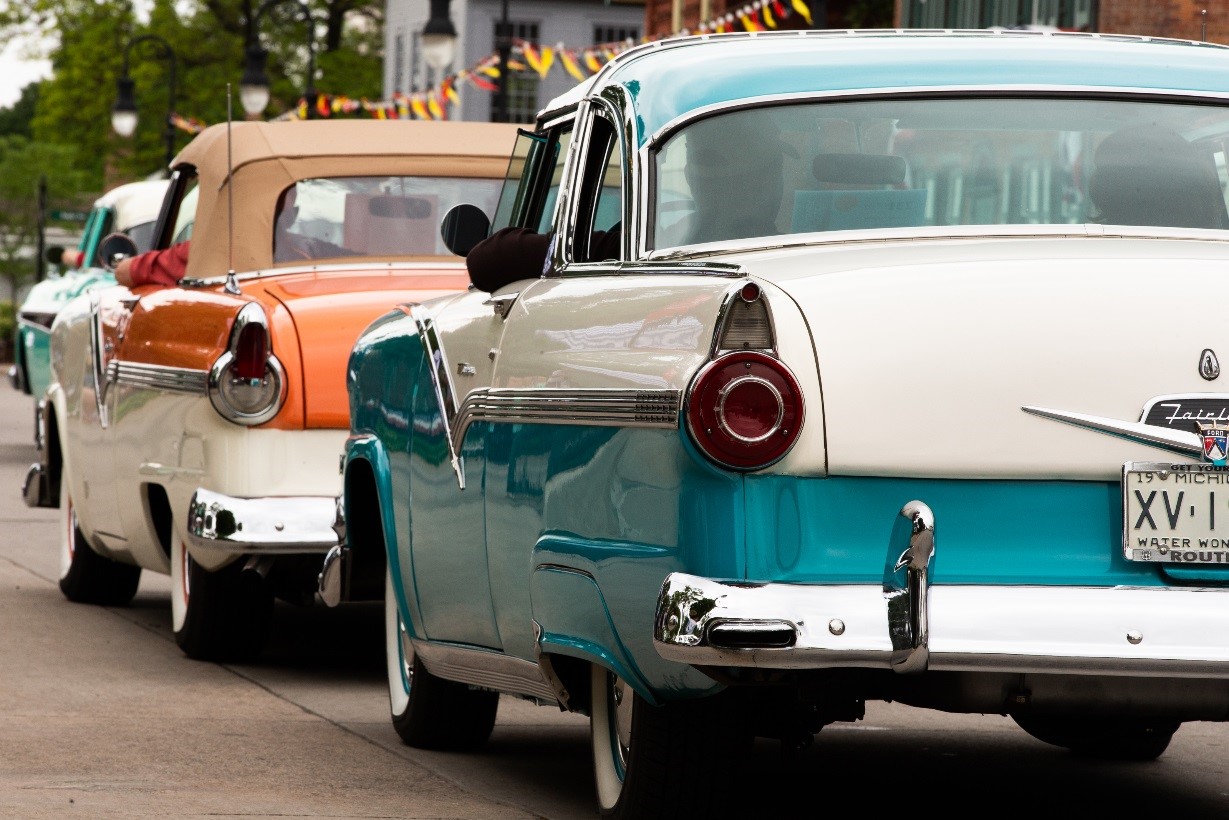
Tailfins, like those sprouting from this 1956 Ford Fairlane, were in the spotlight for 2019.
Gearheads descended on Greenfield Village again this June for our popular Motor Muster car show, featuring more than 600 automobiles, trucks, motorcycles, bicycles, and military vehicles from the 1930s through the 1970s. By our count, this year marked our 30th time presenting this one-of-a-kind event. Based on the crowd, Motor Muster is as popular – and as active – as ever.
Our theme this year was “Fabulous Fins,” those towering tailfins that defined 1950s American automotive design. After several years marking golden anniversaries for 1960s muscle and pony cars, we were overdue for a return to the decade that gave us rock and roll, hula hoops, Corvettes, and Thunderbirds.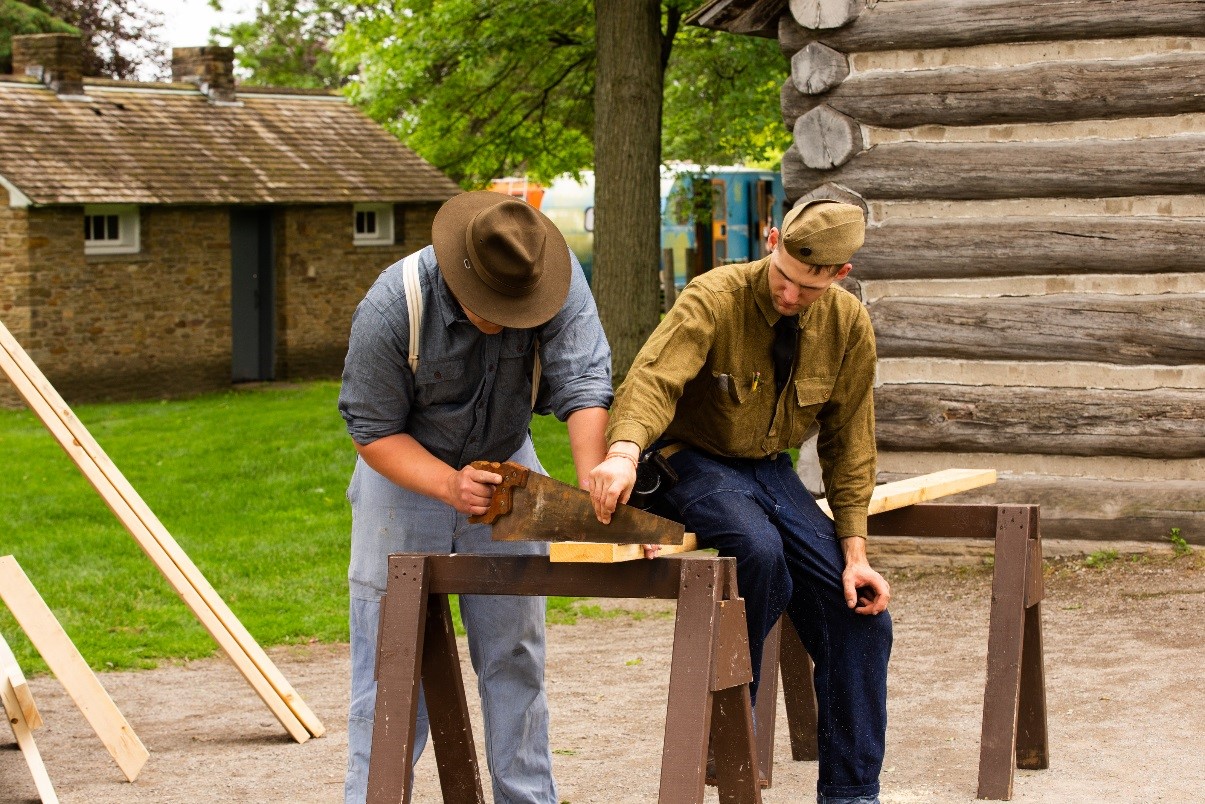
A pair of CCC recruits at work in front of the McGuffey School.
Once again we staged a series of historical vignettes around Greenfield Village that complemented each of the five decades represented in the show. The Depression years of the 1930s were recalled at the McGuffey School, where we staged a 1930s Civilian Conservation Corps camp. The three million young men who participated in the program over its nine-year run helped to plant forests, build parks and roadways, manage floodwaters and erosion, and stock streams and rivers with fish.
Nothing says “1950s suburbia” like a well-trimmed lawn.
We remembered the war years of the 1940s with a victory garden, a scrap drive, and a live radio drama staged in front of visitors. There was food, too, with few menu items more popular than the spam sandwiches made with everyone’s favorite spiced canned ham. The postwar boom brought an exodus to the suburbs as returning GIs bought new homes for their young families. We saluted the proverbial “crabgrass frontier” with a display of vintage lawn mowing equipment. (If you think cutting in the hot sun with a gasoline mower is tough, try doing it with a genuine ’50s push mower!)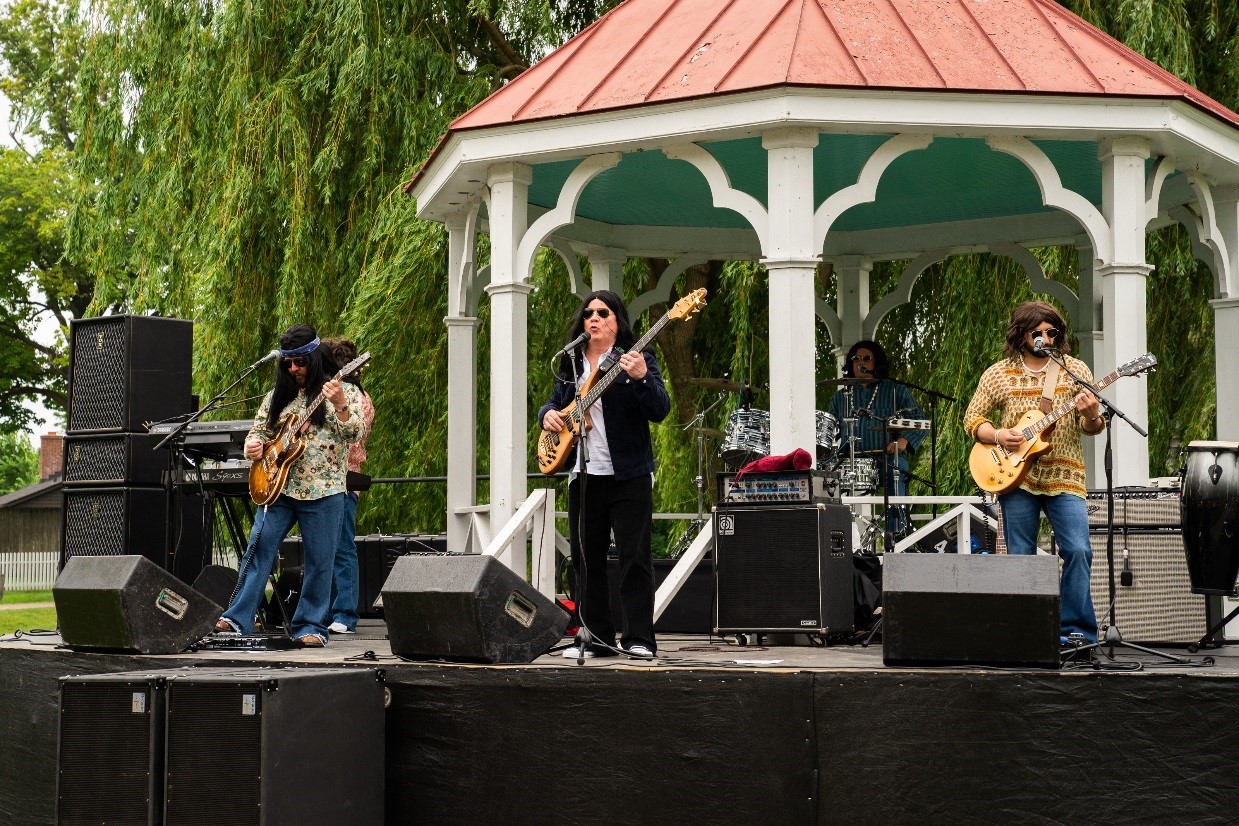
Far out ’70s rock, courtesy of the band Classic Gold, livened up the gazebo near the Ackley Covered Bridge.
For the 1960s, we remembered the classic kids-in-the-station-wagon cross-country family road trip, with an American nuclear family camped around their travel trailer. Interstate highways and economic prosperity opened the country to many families longing to see the U.S.A. in their Chevrolets (or Plymouths, or Fords) that decade. Those looking for a little pre-Fourth of July patriotism had only to wander over to the gazebo near the Ackley Covered Bridge, where we staged a bicentennial-themed picnic straight out of 1976 – complete with a classic rock concert.
This 1959 Corvette lured customers into Bill Fold’s Chevrolet, our vintage dealership vignette.
Perhaps the most immersive vignette this year was another set in the 1950s. For one weekend only, the Village Pavilion became home to Bill Fold’s Chevrolet, a period dealership showcasing Chevy’s new models for 1959. Entering the showroom, visitors encountered a classic family car in the form of an Impala, a tantalizing “new for ’59” model in the form of an El Camino (generously loaned to us from our friends at the GM Heritage Center), and a dreamy halo car in the form of a Corvette. The showroom was complete with a dedicated staff including a receptionist and two eager – make that too eager – salesmen. If those new cars were beyond your budget, Bill Fold’s also had a nice selection of “used” 1955, ’56, and ’57 models parked out front.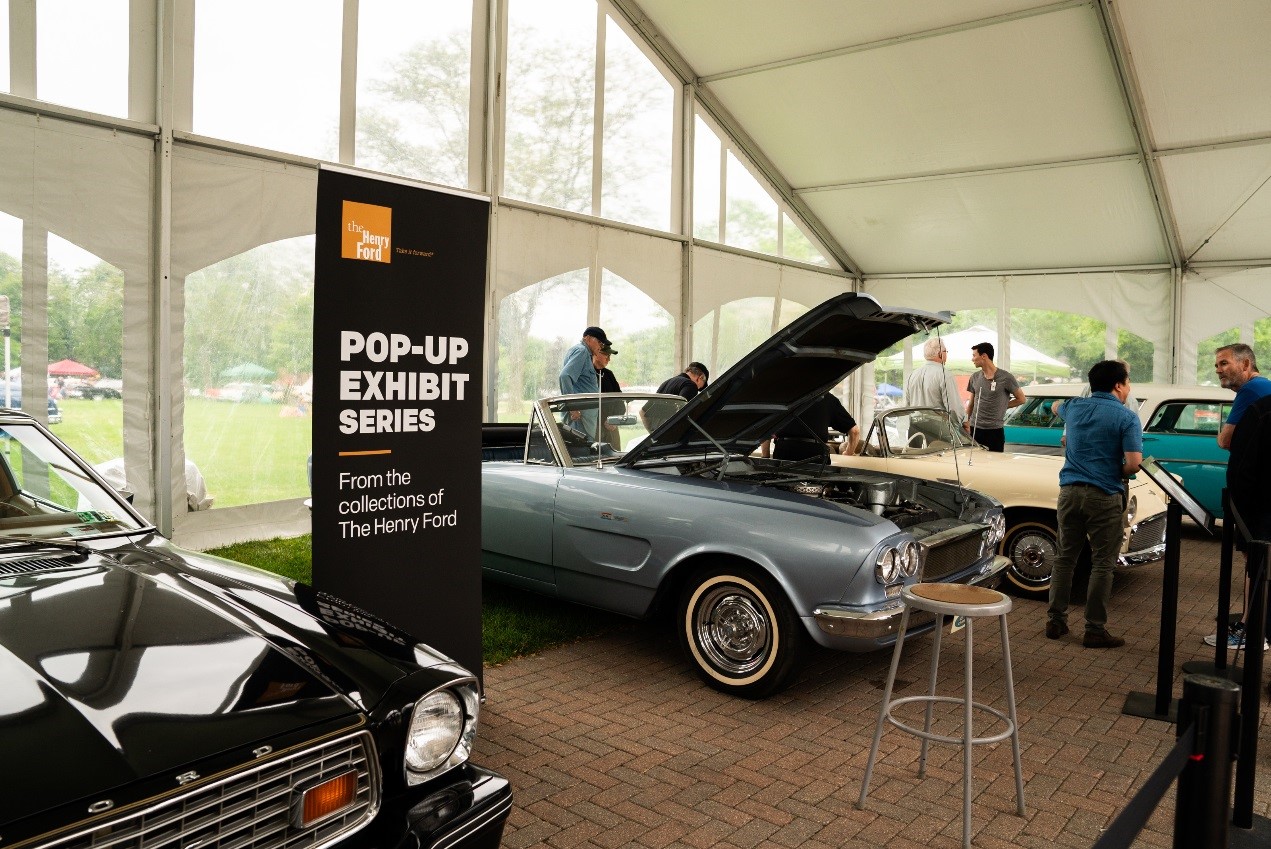
Visitors to The Henry Ford’s tent were treated to (left to right) a Ford Mustang II, a pair of one-of-a-kind Budd Company concept cars, and a 1957 Chevrolet Nomad wagon.
Every year, Motor Muster gives us a chance to display some treasures from The Henry Ford’s own automotive collection. This year we pulled out a pair of concept cars built by the Budd Company in the early 1960s. The XT-Bird was pitched by Budd to Ford Motor Company as a possible revival of the beloved two-seat Thunderbirds of 1955-57. (Though the XT-Bird has a back seat – barely.) Budd took the XR-400 to American Motors Corporation, hoping the company might bite on the idea of a sporty car built on a Rambler chassis. Both were intriguing ideas – each anticipating Ford’s Mustang – but neither went beyond these singular prototypes.
Given our Fabulous Fins theme, we had to have at least one pair of tailfins in our tent alongside the Budd cars. Our friends at the GM Heritage Center came through for us again with a beautiful 1957 Chevrolet Nomad. The sporty two-door station wagons weren’t popular enough to sell in big numbers at the time, but they’re certainly popular with collectors today. We also had one more little jewel from our collection on view, our 1977 Ford Mustang II. It’s one of those cars with no middle ground – you either love it or you don’t. The car received many wide-ranging reactions over the weekend.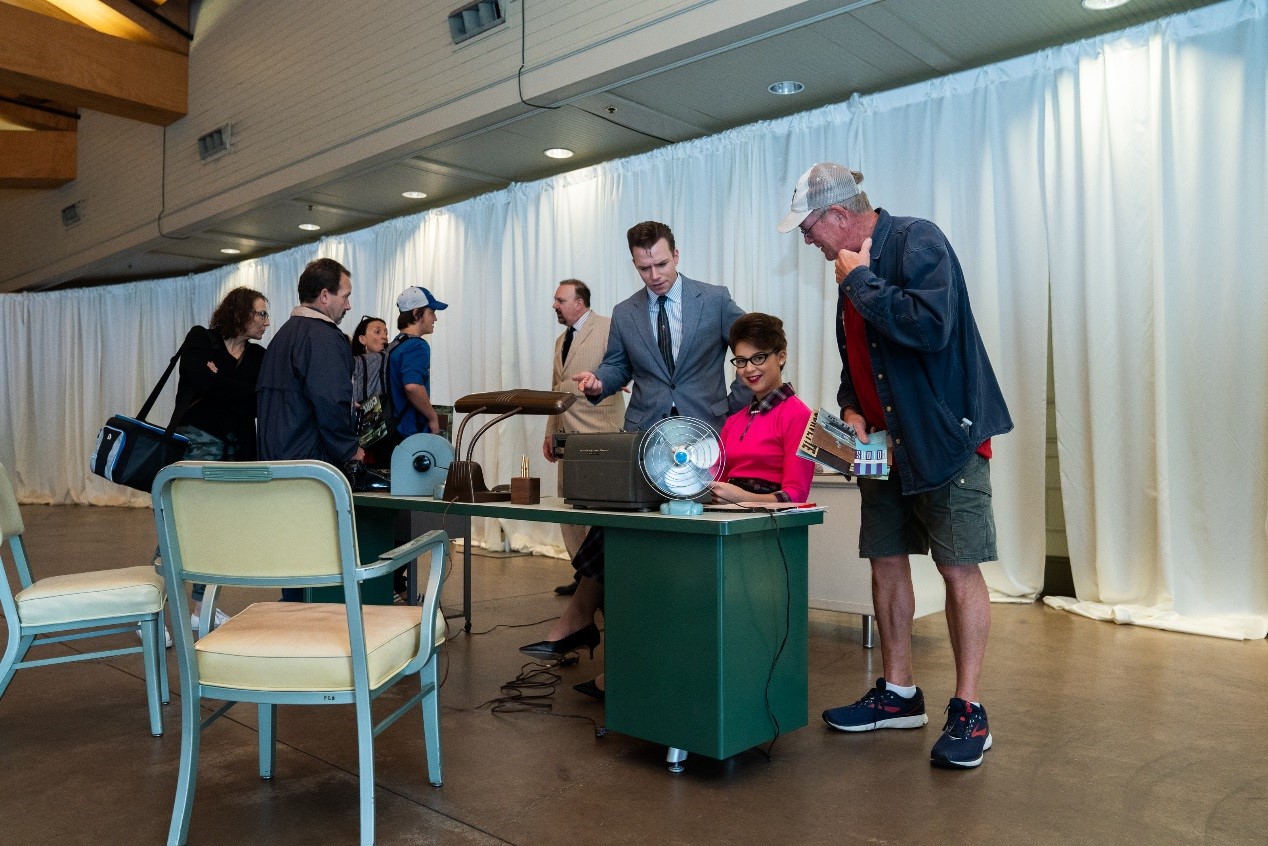
Another look inside Bill Fold’s Chevrolet, with its eager – and slightly smarmy – sales staff.
All in all, a fantastic Motor Muster for everyone who participated – whether they brought a vehicle or just brought themselves. We’ll look forward to seeing you at show number 31 next year.
Matt Anderson is Curator of Transportation at The Henry Ford.
Michigan, Dearborn, 21st century, 2010s, Motor Muster, Greenfield Village, events, cars, car shows, by Matt Anderson
Cars Inspired by the Stars
When it came time to name a new model, or even a new company, automakers often found inspiration in the stars. Astronomical phenomena, planets, and whole galaxies have all found their way onto fender badges and hood ornaments. Here are just a few examples.
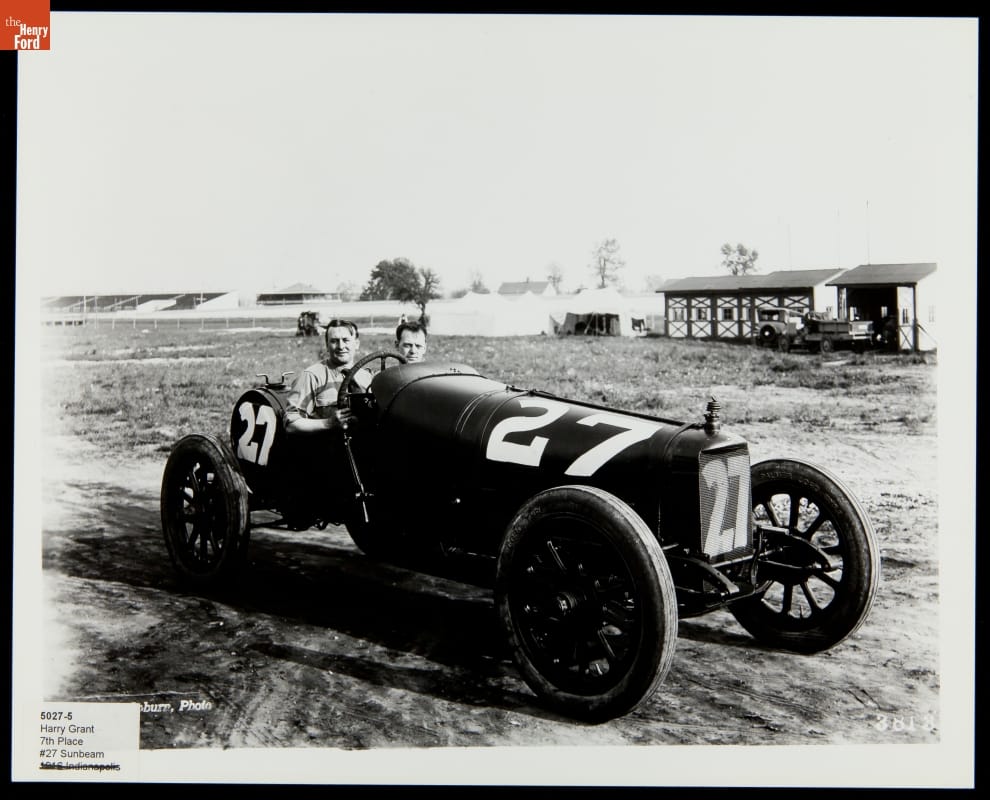
Harry Grant #27 Sunbeam, Indianapolis Speedway, 1914. 2009.103.P.5027.5
Great Britain’s Sunbeam Motor Car Company traces its roots to a bicycle manufacturer founded in 1887. Sunbeam cars raced in Grand Prix events and competed for land speed records. Harry Grant finished seventh in a Sunbeam at the 1914 Indianapolis 500. The company closed during the Great Depression, but the Sunbeam name survived a while longer under new ownership.
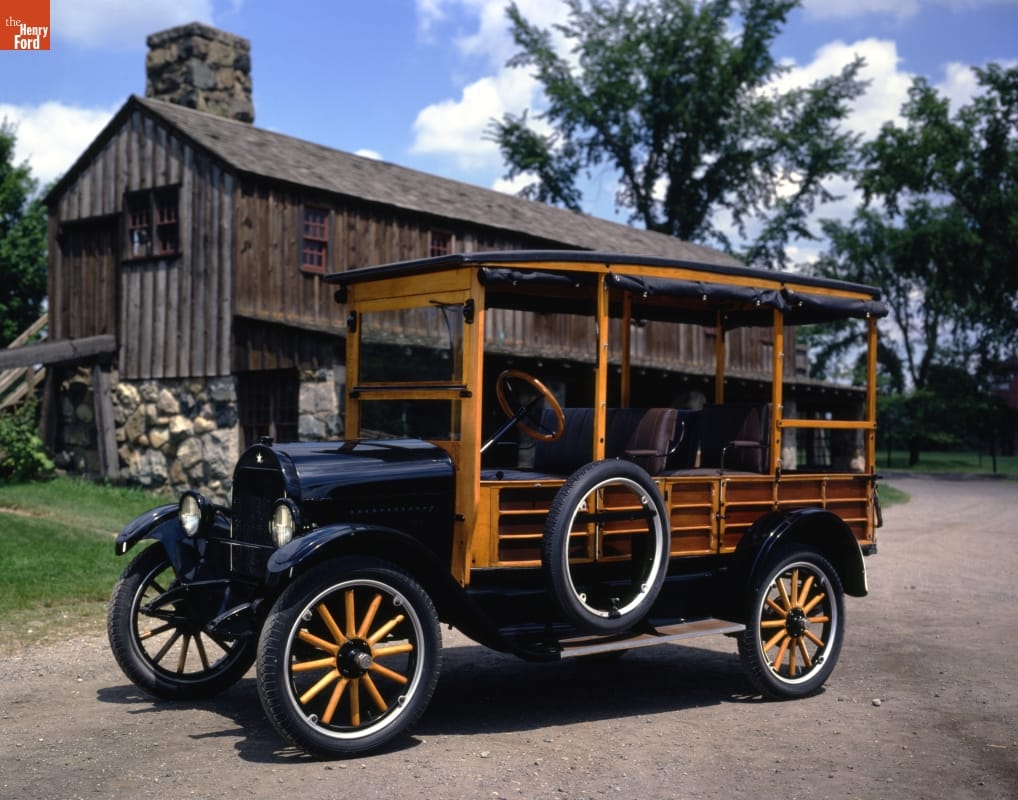
1923 Star Station Wagon. 83.16.1
After being driven out of General Motors for a second – and final – time, Billy Durant founded Durant Motors in 1921. He christened his low-priced model Star and set his sights on Ford’s Model T. While Star never seriously threatened the T, it did introduce the first factory-built station wagon.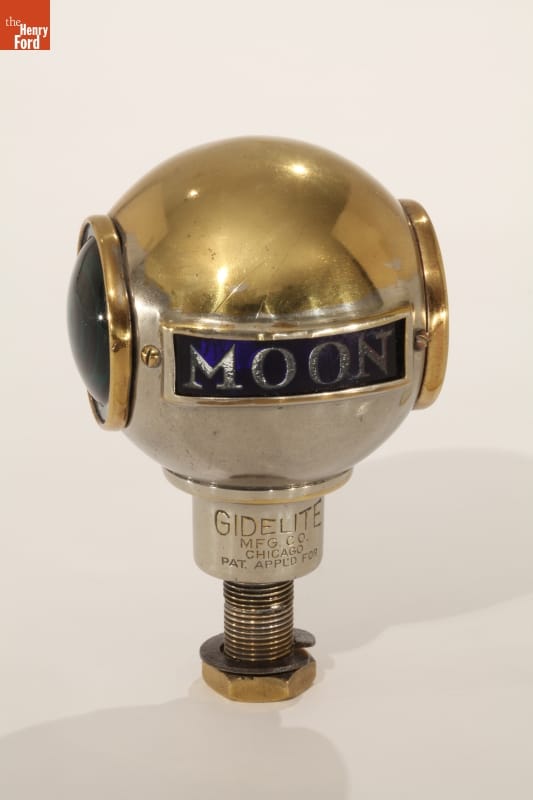
Moon Motometer, circa 1925. 81.99.94
Strictly speaking, the Moon Motor Car Company of St. Louis was named for its founder, Joseph W. Moon, but a crescent Moon logo turned up in its advertisements from time to time. The automaker remained in business from 1905 to 1930. Its name is proudly featured on this motometer – a device for measuring engine coolant temperature.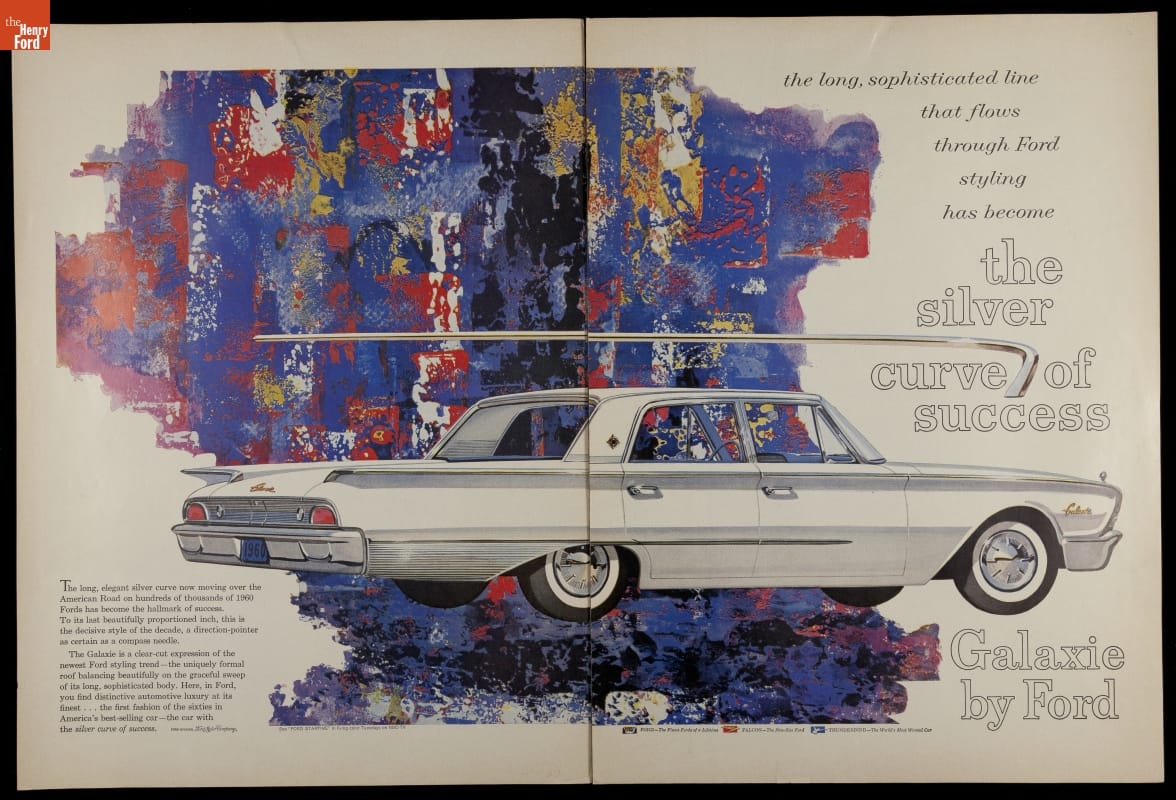
1960 Ford Advertisement, “The Silver Curve of Success – Galaxie by Ford.” 87.14.14.19
When the Russians launched Sputnik – the first artificial Earth satellite – in 1957, it kicked off a “Space Race” between the Soviet Union and the United States. In turn, that competition inspired a series of space-inspired car names like Ford’s Galaxie. When introduced for 1959, Galaxie was the company’s top trim level for its full-sized models.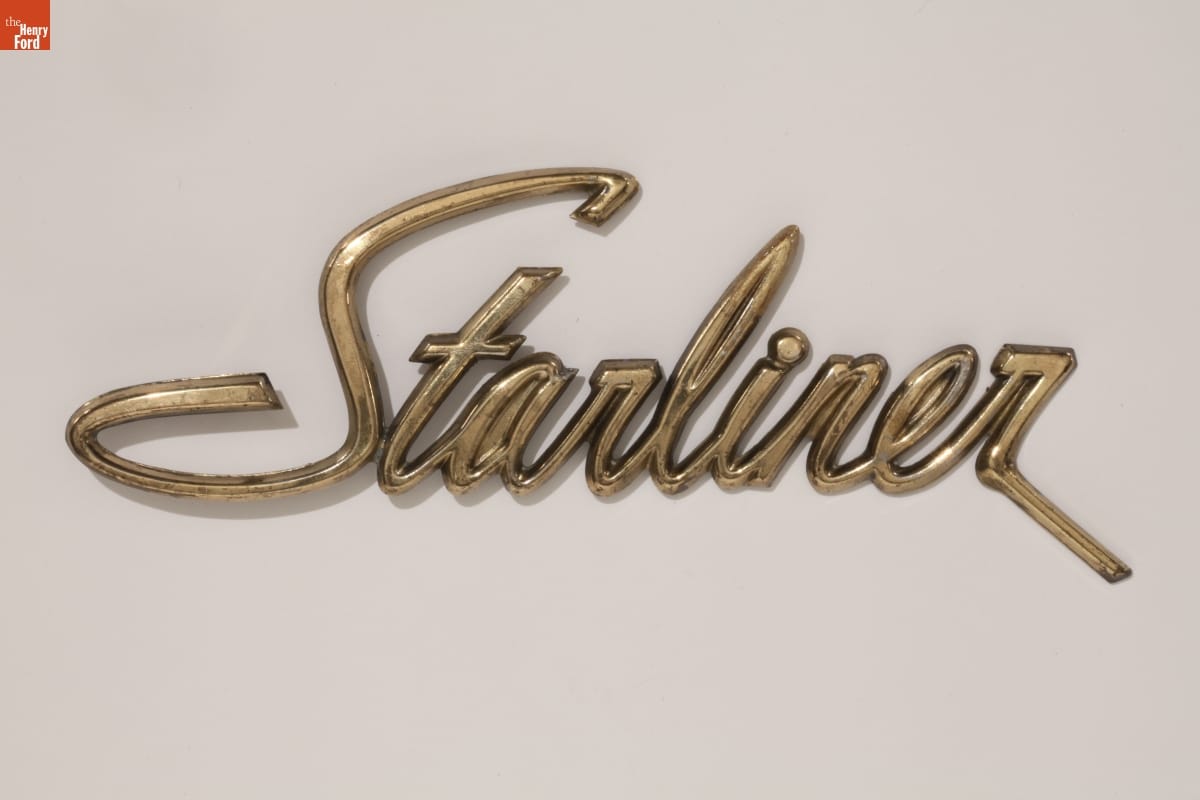
Ford Starliner Nameplate, 1960-1961. 2011.316.1
For 1961, Ford introduced a fastback version of the Galaxie, appropriately named Starliner. Studebaker had previously used the Starliner name on a series of striking coupes designed by Robert E. Bourke of Raymond Loewy Associates and produced from 1952 to 1954.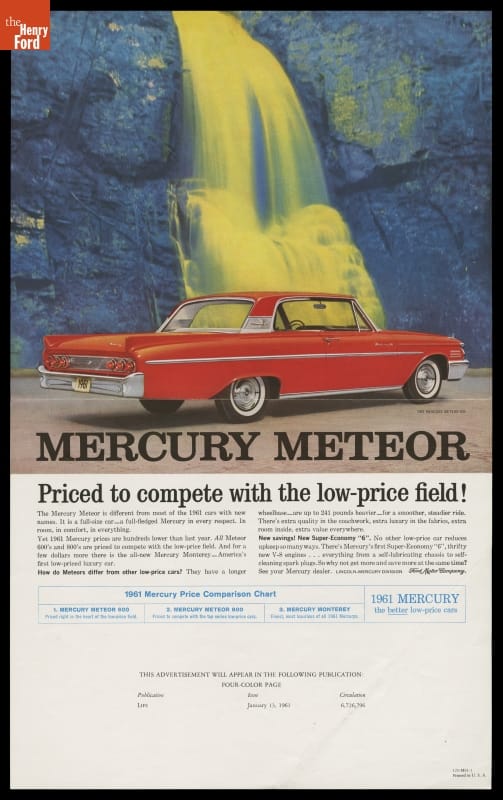
1961 Mercury Meteor Advertisement, “Priced to Compete with Low-Price Field!” 64.167.19.225
Mercury (itself a celestial name – though inspired by the Roman god and not the planet) introduced its Meteor model for 1961. Never a strong seller, Meteor was discontinued after the 1963 model year. The name enjoyed a longer life in Canada, where Ford used it to denote a distinct brand of cars – not just a model – from 1949 to 1976.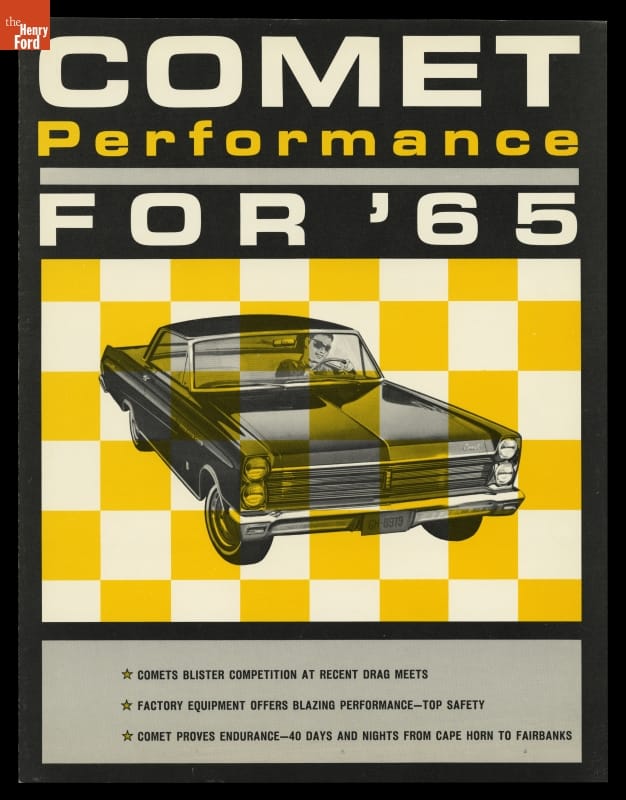
Brochure, “Comet Performance for ’65” 2007.1.1930.25
Ford introduced the Comet – initially a distinct brand – for 1960 as an upscale version of the compact Falcon. For 1962, Comet became a Mercury model. In the mid-1960s, Comets were offered with special options packages tailored for NHRA drag racing.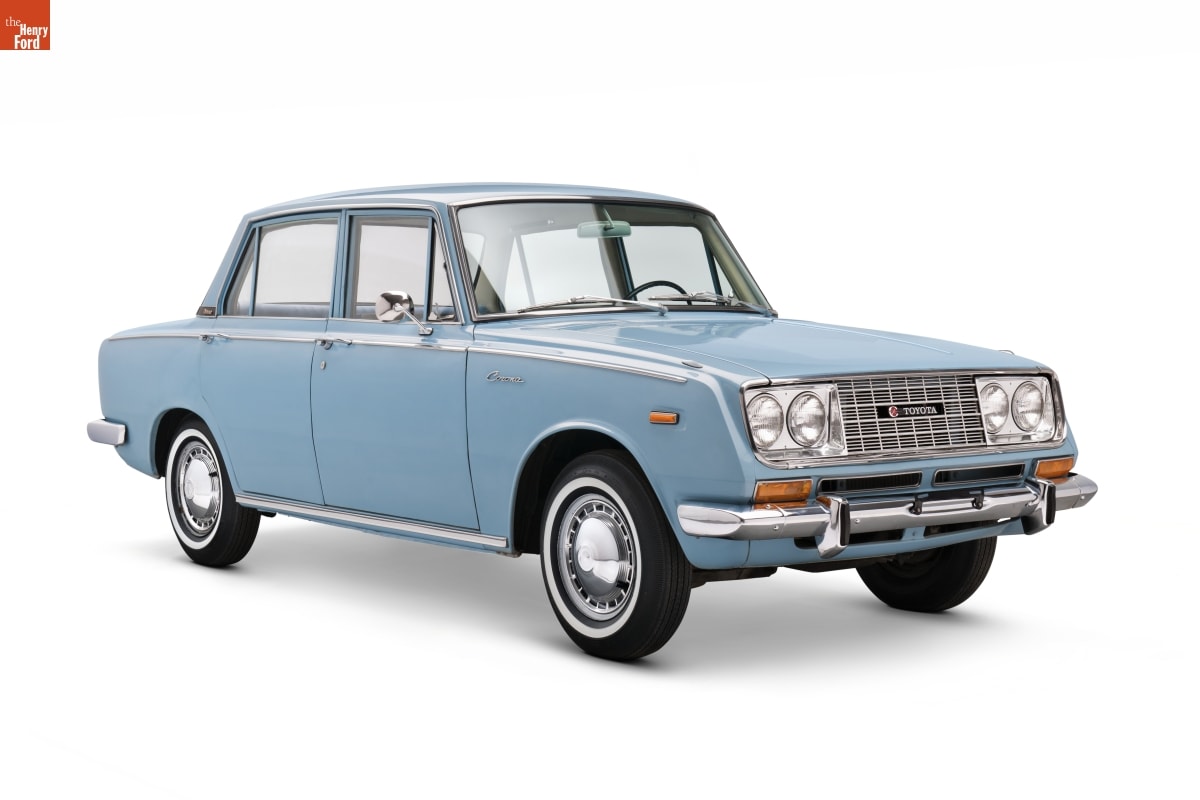
1966 Toyota Corona Sedan. 87.120.1
Corona – named for the plasma aura surrounding the Sun – was the perfect name for the first truly successful car imported to the United States from Japan, the Land of the Rising Sun. Unlike Toyota’s first attempt for the American market – the overpriced and underpowered Toyopet – the Corona did well with stateside buyers.
Plymouth Satellite Custom Nameplate, 1968-1969. 2011.239.1
Like the Dodge Polara before it, the Plymouth Satellite brought cosmic lexicon to Chrysler’s product line when introduced for 1965. Satellite denoted the top trim level for Plymouth’s mid-sized Belvedere line until 1967, when the GTX designation superseded it. The Satellite name was phased out completely after 1974.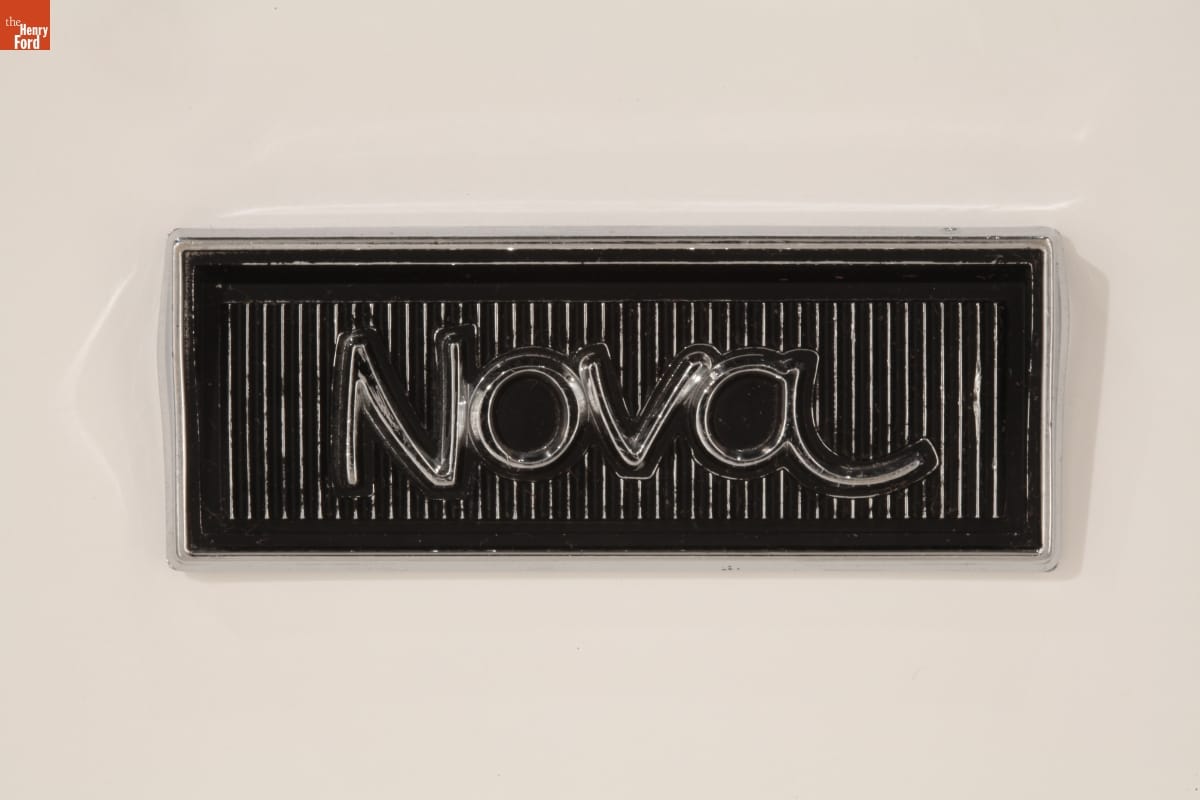
Chevrolet Nova Dashboard Emblem, 1968-1972. 2011.291.3
To astronomers, nova refers to a star that shows a sudden, temporary increase in brightness. To gearheads, it’s a compact car built by Chevrolet from 1962 through 1979. Initially, Nova was merely the top trim-level designation while the model itself was called Chevy II. Nova replaced Chevy II as the model name in 1969.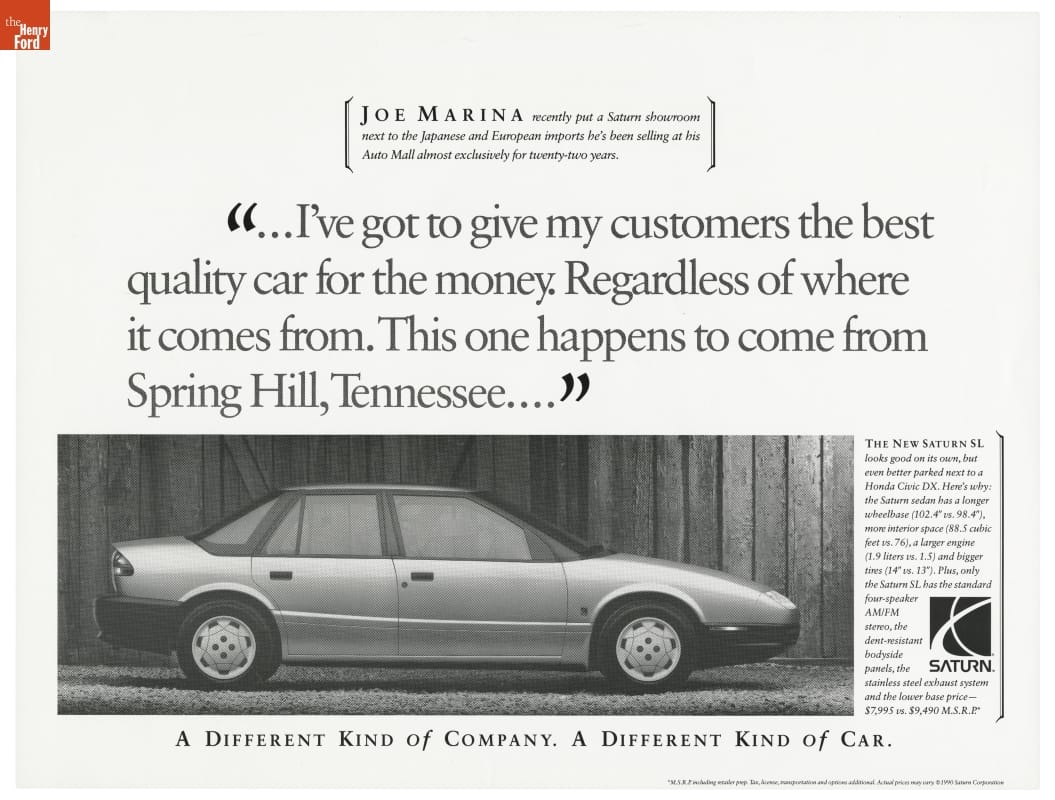
1990 Saturn Advertisement, “A Different Kind of Company. A Different Kind of Car.” 91.83.13
In 1985, General Motors launched a new automobile division intended to compete with Japanese imports. To GM executives, the ambitious project was akin to NASA’s venerable Apollo program, so they named their new division Saturn in homage to the Saturn V rockets that launched American astronauts toward the Moon. After some early success, GM dissolved Saturn in 2010.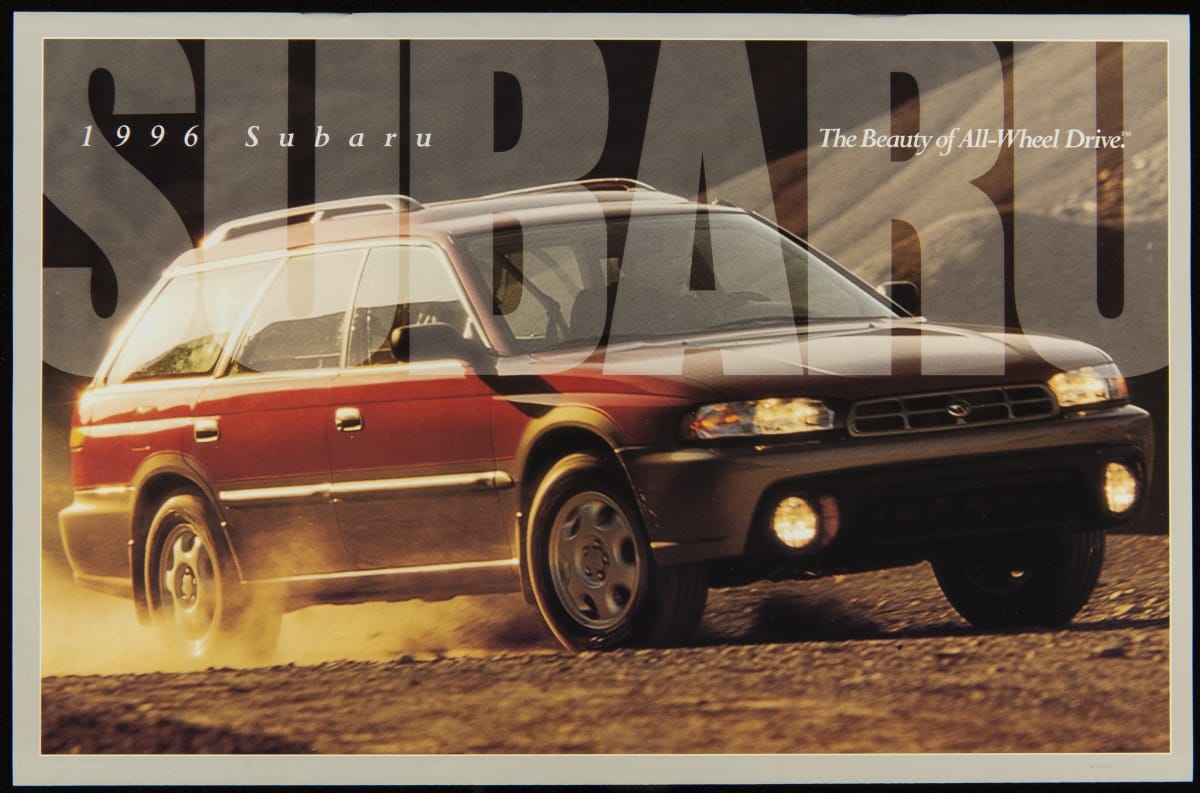
Subaru Sales Brochure, “The Beauty of All-Wheel Drive,” 1996. 2000.16.3
In the United States, stargazers refer to the Pleiades star cluster as the Seven Sisters, after the seven sisters of Pleiades in Greek mythology. In Japan, it’s called Subaru – namesake of the carmaker known for its boxer engines and rugged wagons. According to mythology, one of the seven sisters is invisible, so you’ll count just six stars in Subaru’s logo.
Matt Anderson is Curator of Transportation at The Henry Ford.
We don’t generally associate Star Trek with historic automobiles (or, for that matter, with any automobiles). The classic original series is set circa 2265-2269, nearly 360 years after the first Model T rolled out of Ford’s Piquette Avenue Plant. By all evidence, Federation citizens in the 23rd century are content to get around by spaceship and shuttlecraft (with the notable exception of the Jupiter 8). But who can blame them for not driving? After all, we’re talking about a universe in which teleportation is a thing. But Star Trek isn’t an entirely auto-free zone. Through the clever storytelling devices of science fiction, Kirk, Spock, and McCoy encounter multiple 20th century American cars over the course of the show.
Ask fans to name their favorite episodes and you’ll likely hear “The City on the Edge of Forever” mentioned several times. The romantic yarn, which closed the first season, finds the crew of the Enterprise in a time-traveling misadventure. Dr. McCoy, less than lucid after an accidental overdose of medication, charges through a temporal gateway into New York City circa 1930. Kirk and Spock follow their ailing comrade and discover that McCoy has inadvertently altered history with serious consequences. Our heroes manage to put things right, but not without considerable anguish on Kirk’s part.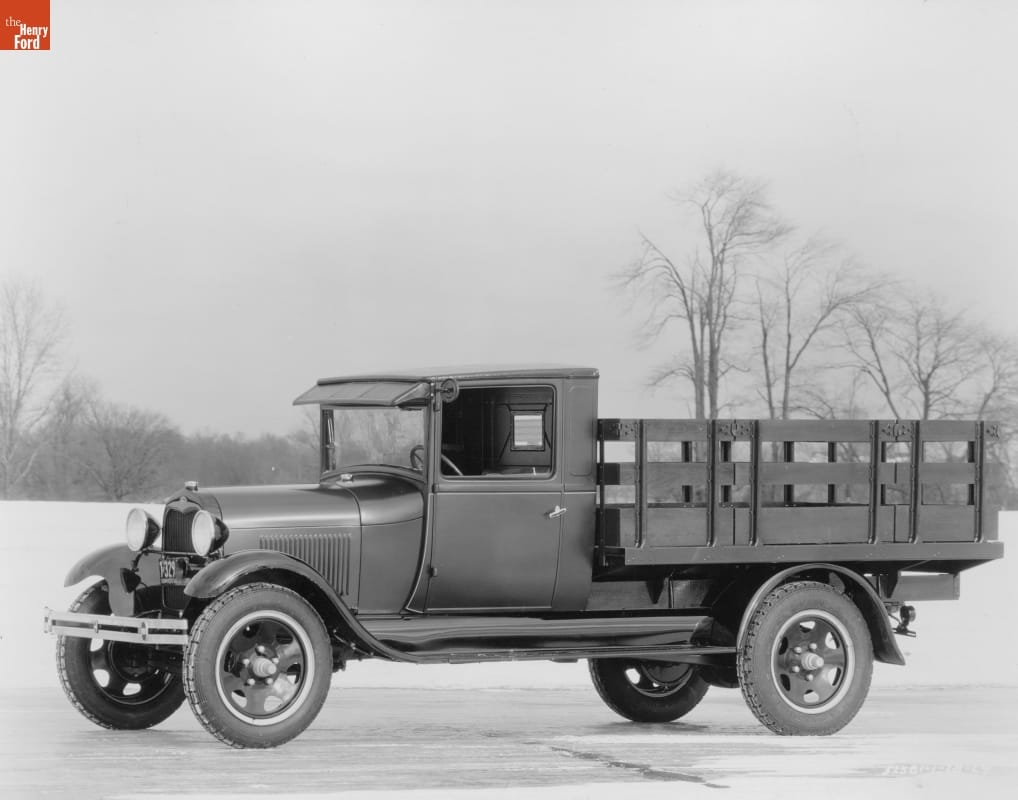
Ford’s 1929 Model AA stake body truck, similar to one seen in “The City on the Edge of Forever.” (THF28278)
The episode features several period automobiles including a 1930 Buick, 1928 and 1930 Chevrolets, and a circa 1930 Ford Model AA truck. Most are in the background, but a 1939 GMC AC-series truck plays a crucial part in the story. In fact, it’s not too much to say that the whole plot depends on it. (Beware of the spoiler at this link.) No, a ’39 truck has no business being on the streets of New York in 1930, but we’ll just let that slide.
The crew returns to a circa 1930 setting in the memorable season two episode “A Piece of the Action.” But this time they’re not on Earth. The Enterprise arrives at the planet Sigma Iotia II, last visited by outsiders before implementation of the Federation’s sacrosanct Prime Directive – barring any interference with the natural development of alien cultures. Kirk and company discover that the planet was indeed contaminated by those earlier visitors. They left behind a book on Chicago gangsters in the 1920s, and the Iotians – a society of mimics – have modeled their planet on that tome, with the expected chaotic results.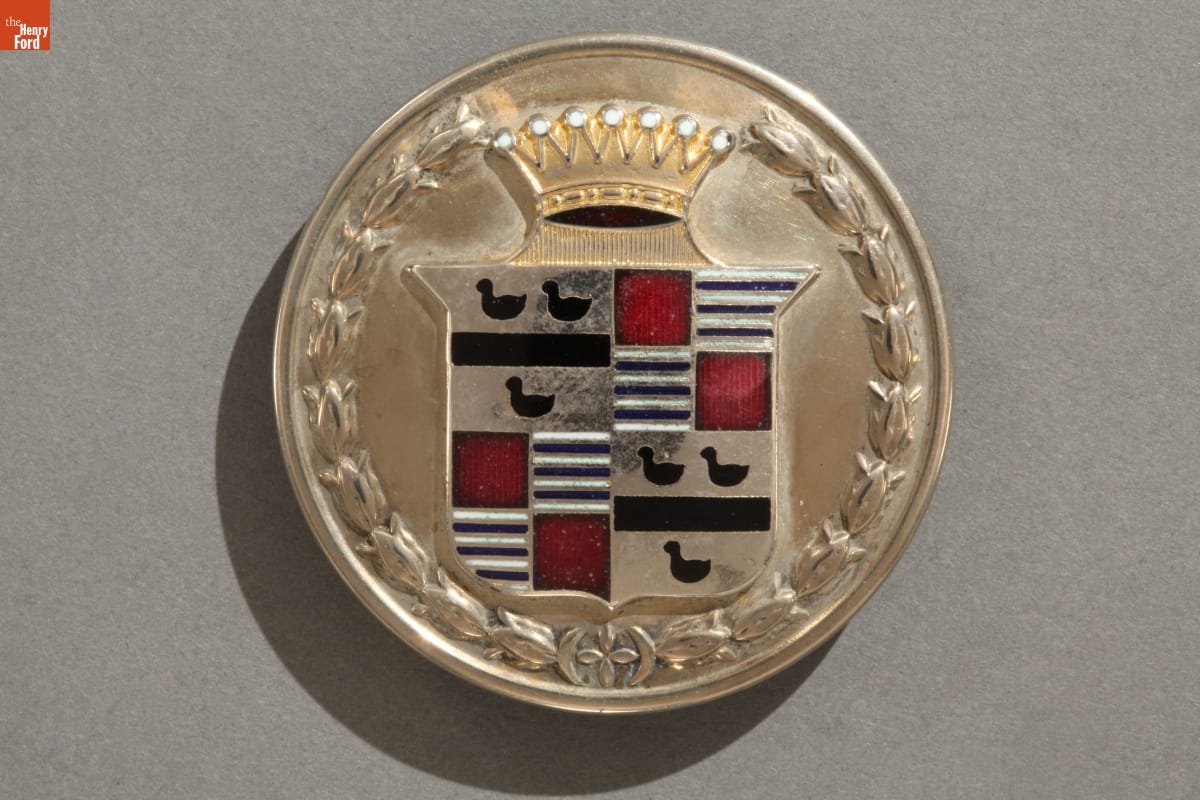
Cadillac, the choice of discerning Starfleet officers. (THF103936)
Those industrious Iotians somehow managed to replicate a host of 1920s and 1930s American cars. Look for a 1929 Buick, a 1932 Cadillac V-16, and a 1925 Studebaker in the mix. But the star car undoubtedly is the 1931 Cadillac V-12 used by Kirk and Spock. It’s one of the few times you’ll see Kirk drive, and it makes for one of the episode’s more amusing scenes. Give one point to Spock for knowing about clutch pedals, but take one point away for his referring to the Caddy as a “flivver.” One could quibble with ’30s cars appearing in a ’20s setting – but one should also remember that this isn’t Earth. We can’t expect the Iotians to get all the details right!
It’s also worth taking a look at season two’s final episode, “Assignment: Earth.” The Enterprise travels back in time to 1968 to conduct a little historical research on Earth. They cross paths with the mysterious Gary Seven, an interstellar agent on a mission of his own to prevent the launch of an orbiting missile platform that will – apparently – lead to nuclear war. It sounds like something right out of “Star Wars.” (No, not that Star Wars, this “Star Wars.”)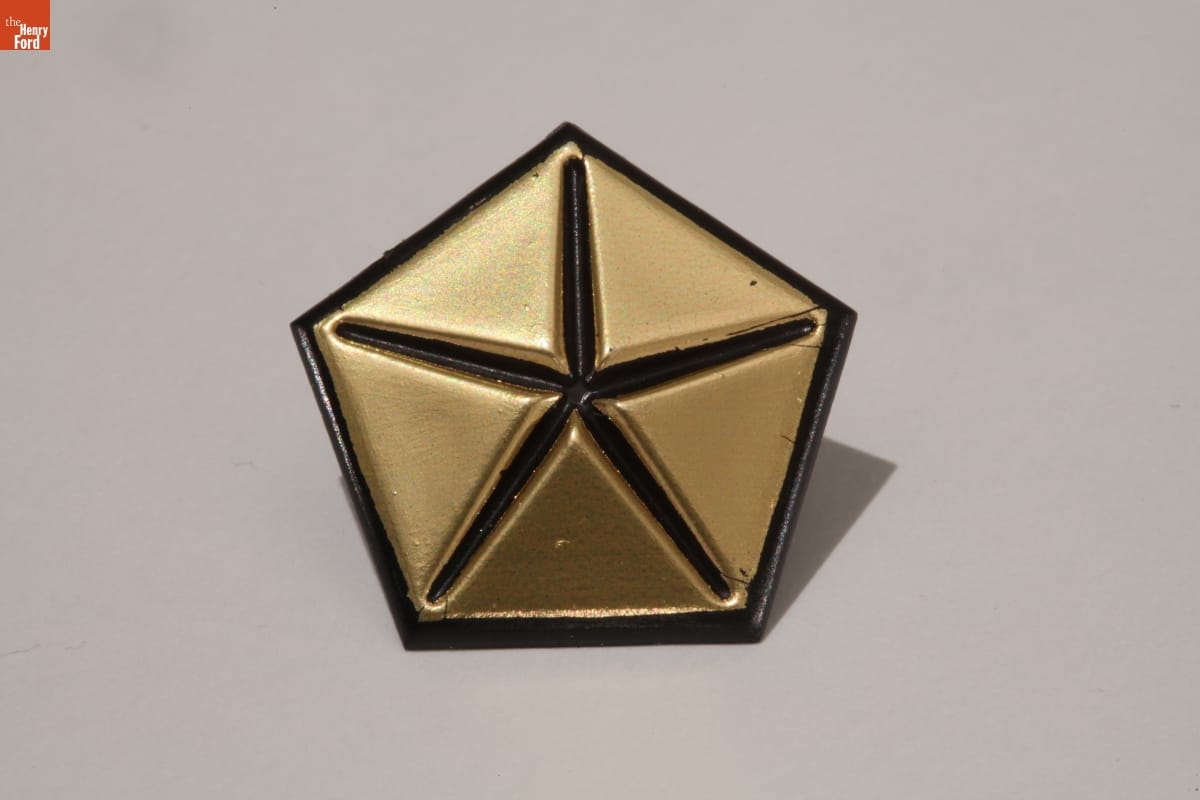
Based on the Department of Defense cars seen in “Assignment: Earth,” it seems the Pentagon prefers Plymouths. Now why could that be? (THF150740)
It’s all very complicated, but it provides another opportunity to see some vintage wheels. (Well, vintage to us and to the Enterprise crew. To TV audiences in 1968, these were contemporary cars.) Pay attention and you’ll spot a number of government agency vehicles including a 1963 Plymouth Savoy, a 1967 Dodge Coronet, and a 1968 Plymouth Satellite (the latter being particularly apropos for a space series). For those who aren’t Mopar fans, look quickly and you’ll also spy a 1966 Ford Falcon in the episode.
Okay, so no one will ever confuse Star Trek with Top Gear. But, if you keep your eyes peeled, every now and then you’ll find a little gasoline to go along with all of that dilithium. After all, sometimes the boldest way to go is the oldest way to go.
Matt Anderson is Curator of Transportation at The Henry Ford.
by Matt Anderson, cars, popular culture, TV, space, Star Trek
It’s not every day that you get to see a newly acquired artifact in action – in Greenfield Village just weeks before the opening of the 2019 season.
Meet the 1971 Wooster, Ltd. Sno-Bob, recently acquired by The Henry Ford. A Sno-Bob, also referred to as a ski bike, ski bob, or ski toy, is a bicycle frame attached to skis instead of wheels, or sometimes to a set of foot skis. The origins of bicycle-ski contraptions like the Sno-Bob date back to the mid-1800s. Equipped with real skis and a steering system to give the rider more control than a standard sled, the Sno-Bob is a unique offering in the world of winter toys.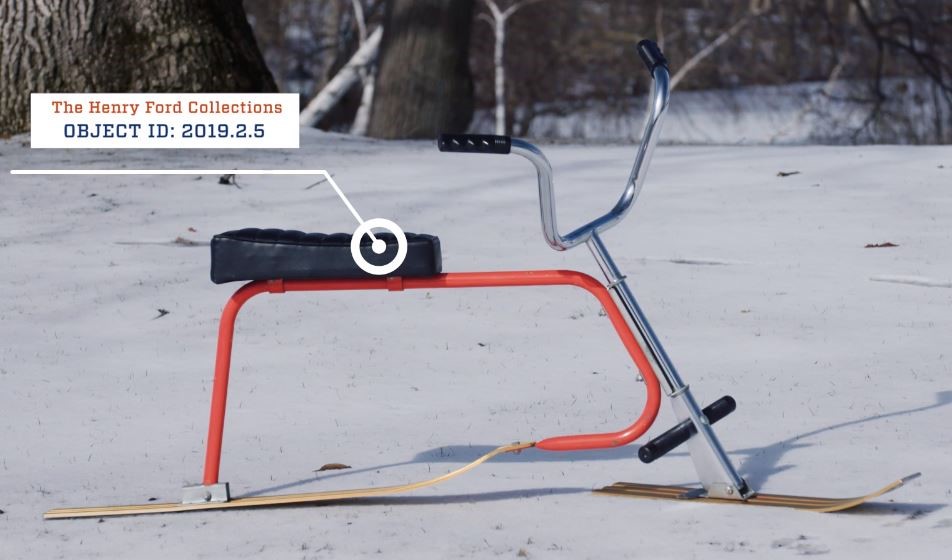
The Sno-Bob isn’t just a fun winter-themed toy, it’s a bit of a rare find for our collections. As a society, we don’t buy as many snow toys to begin with, let alone save them to be possibly donated to a museum in the future. The Sno-Bob also has a connection to the Beatles, too: those loveable Liverpudlian mop tops ride Sno-Bobs in the Austrian Alps during the “Ticket to Ride” sequence in Help!, their second movie.
While not quite the Austrian Alps, you can see our Sno-Bob in action in Greenfield Village earlier this winter as Conservator Cuong Nguyen takes it out for a spin. While we generally don’t “play” with the artifacts in our collection, we feel that this toy is unique enough to justify video documentation showing how it’s used. (We’re fortunate that the weather cooperated with our plans this winter.)
2010s, 21st century, 20th century, 1970s, winter, toys and games, by Matt Anderson, by Jeanine Head Miller, by Charisma Tatum, #Behind The Scenes @ The Henry Ford
Our First Autonomous Car: The 2016 General Motors Self-Driving Test Vehicle
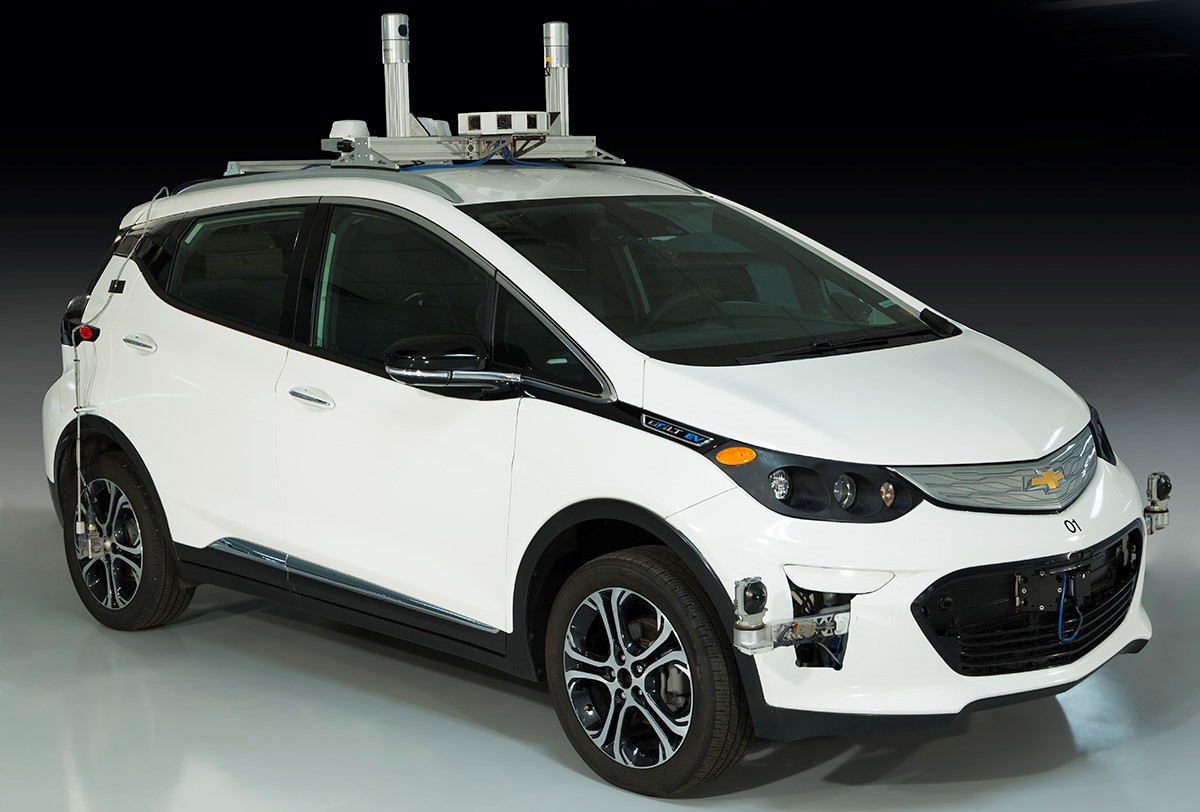
The Henry Ford’s newly-acquired 2016 General Motors First-Generation Self-Driving Test Vehicle.
There are some 300 automobiles in the collections of The Henry Ford. We’ve got pioneering cars, world-changing cars, luxury cars, muscle cars, pony cars, family cars, economy cars, presidential cars, even cars shaped like food. But we’ve never had anything quite like this. Thanks to our friends at General Motors, we’ve now acquired our first self-driving car: a 2016 GM First-Generation Self-Driving Test Vehicle.
Anyone who’s been following automotive news – or any news – over the past few years knows that autonomous vehicles are no longer science fiction. They’re here today, right now. Sure, they may not be in every garage just yet, but in cities like San Francisco, Las Vegas, Phoenix, and even right here in Dearborn, they’re practically everyday sights as engineers put increasingly-refined prototypes through their paces on public roads.
Continue ReadingCalifornia, 21st century, 2010s, technology, cars, by Matt Anderson, autonomous technology
Autorama 2019: A Visit to Hot Rod Heaven
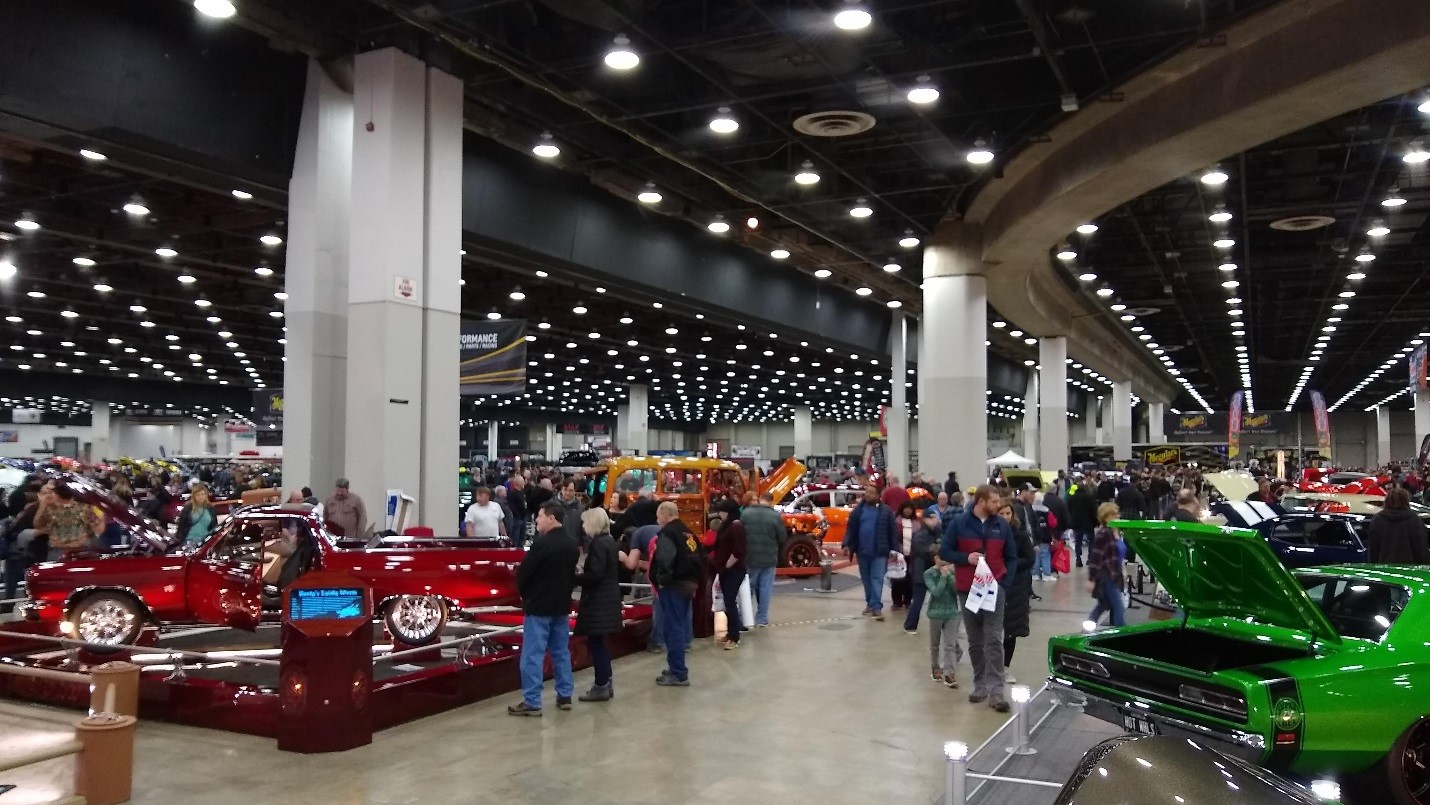
Cobo Center brimmed with more than 800 custom cars and hot rods at the 2019 Detroit Autorama.
Winter was a little late arriving here in southeast Michigan, and it doesn’t seem to be in any hurry to leave. But the colder-than-average temperatures made it all the more satisfying to check out the hot cars at the 67th Annual Detroit Autorama.
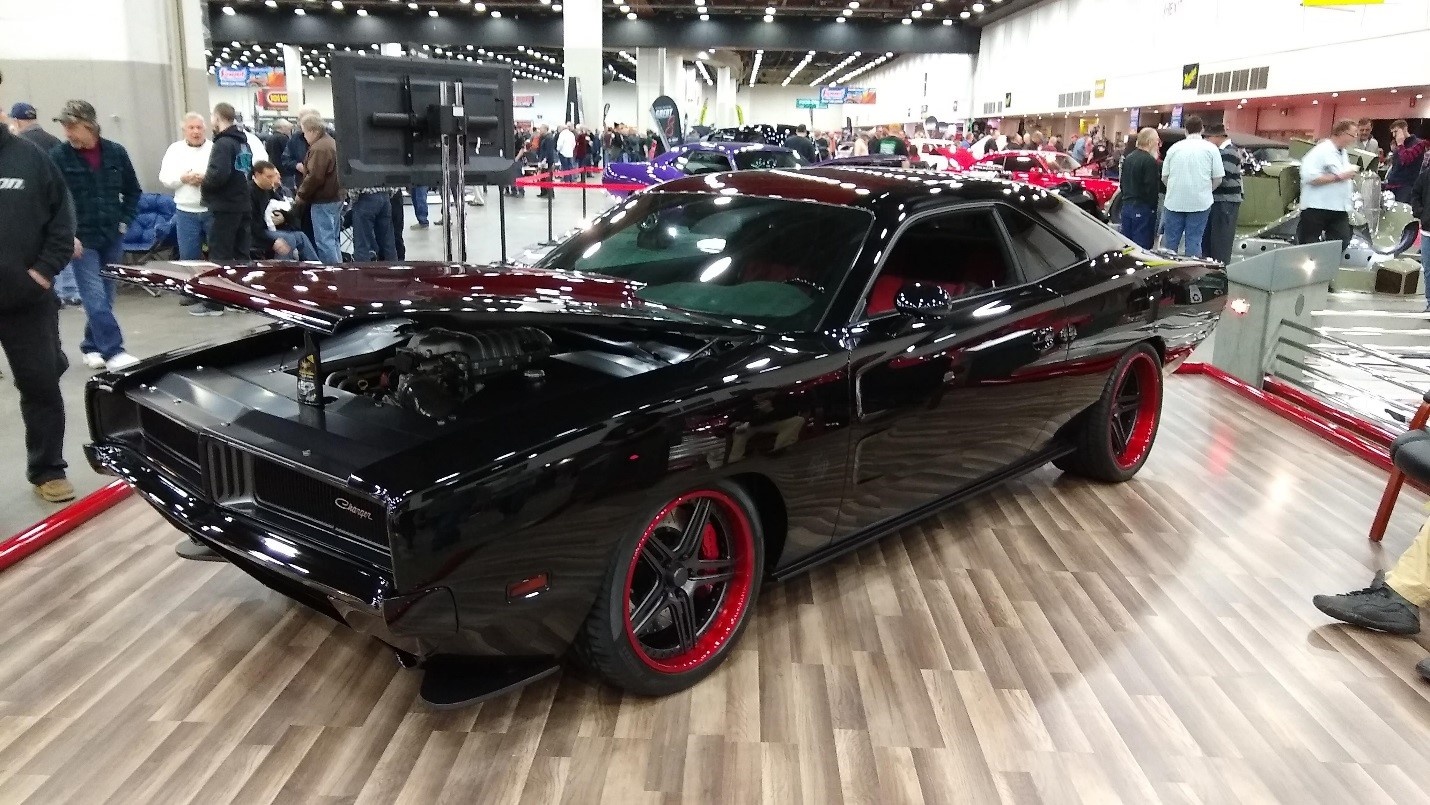 A superb blend of old and new – a 2018 Dodge Charger Hellcat with the face and Coke bottle doors of its timeless 1969 predecessor.
A superb blend of old and new – a 2018 Dodge Charger Hellcat with the face and Coke bottle doors of its timeless 1969 predecessor.
Anyone in the hobby knows that Detroit’s Autorama is among the most prestigious hot rod and custom car shows in the world. More than 800 cars from throughout the United States and Canada come together at Cobo Center to be judged on their craftsmanship and creativity. The best entrants join Autorama’s “Great 8.” And from these eight finalists, judges choose the winner of the best-in-show Ridler Award. Only cars that have never been shown before are eligible to win, so it’s a special honor indeed. In addition to the bragging rights, the Ridler winner receives $10,000 and enshrinement in the online Winner Archive. This year’s Ridler Award went to “Cadmad,” a wild 1959 Cadillac Eldorado Brougham station wagon owned by Steve Barton of Las Vegas, Nevada. Mr. Barton passed away before the car was completed, giving added poignancy to this year’s prize.
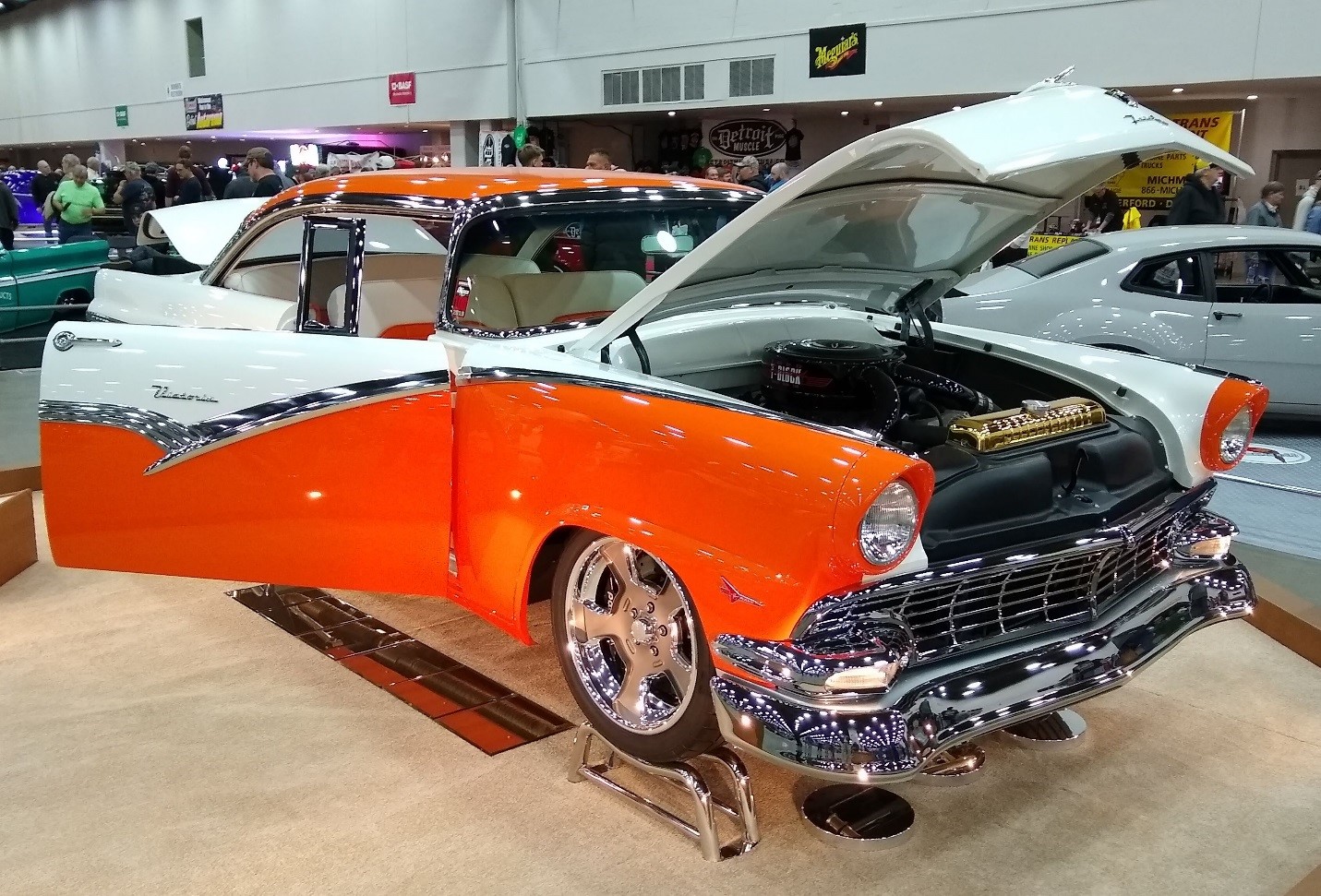 Wes Adkins’s 1956 Ford Victoria took home The Henry Ford’s “Past Forward” award.
Wes Adkins’s 1956 Ford Victoria took home The Henry Ford’s “Past Forward” award.
For the sixth year The Henry Ford presented its “Past Forward” award at the Detroit Autorama. Our prize goes to a car that 1.) Blends custom and hot rod traditions with modern innovation, 2.) Exhibits a high level of craftsmanship, 3.) Captures the “anything goes” spirit of the hobby, and 4.) Is just plain fun. Our winner this year was a 1956 Ford Victoria owned by Wes Adkins of Dover, Ohio. The Victoria features a 301-cubic inch Y-Block V-8 with twin superchargers; hand-crafted rocker panels, floors, and inner fenders; vintage Thunderbird door handles; and a 3D-printed hood ornament – at 60 percent the size of the original for a lower-profile look. Everything was beautifully executed – particularly the paintwork, done by the owner himself.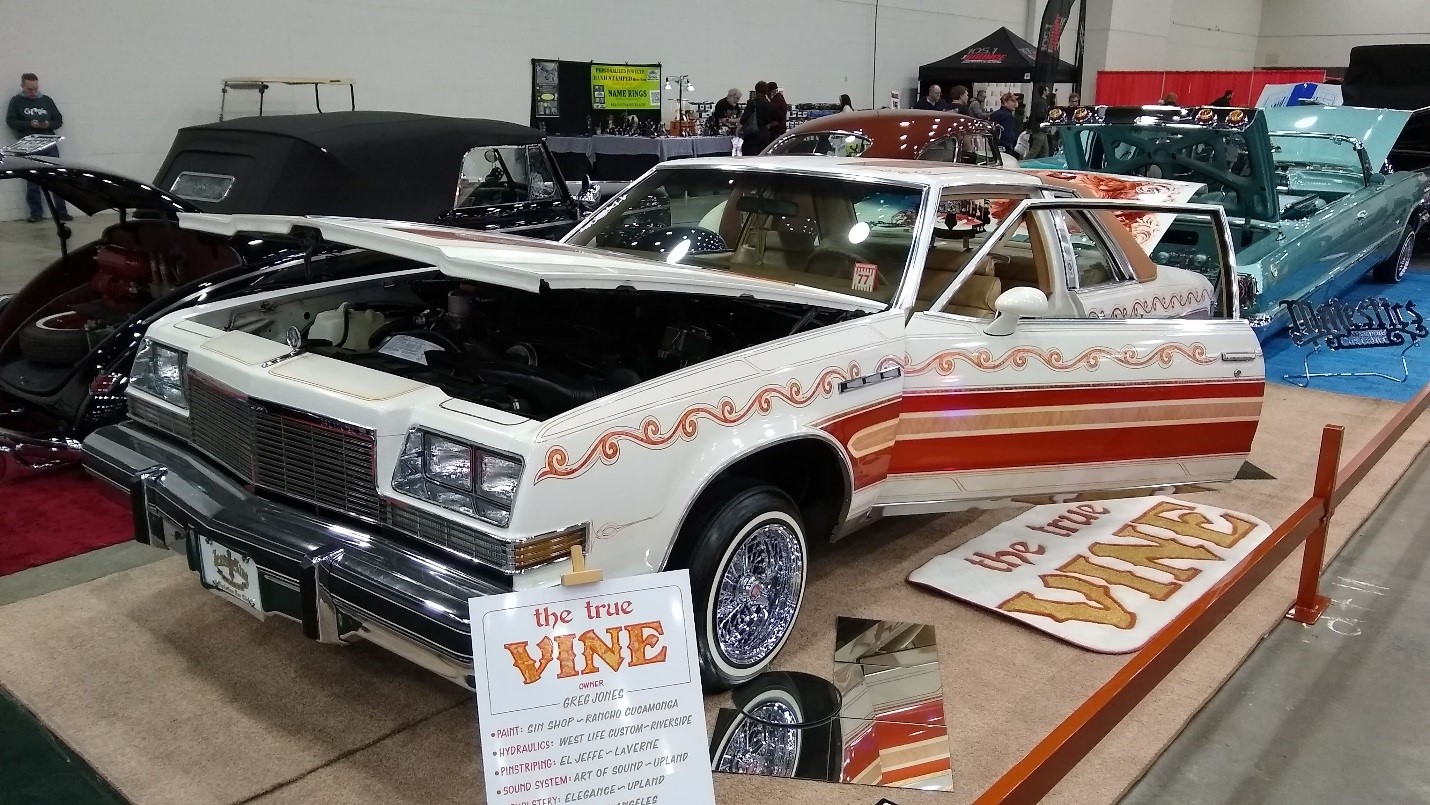 “The True Vine” – a 1977 Buick LeSabre at Autorama’s Low Rider Invitational.
“The True Vine” – a 1977 Buick LeSabre at Autorama’s Low Rider Invitational.
This year brought a special milestone as the Detroit Autorama hosted its first-ever Low Rider Invitational. Some 14 cars from Michigan and Ohio were featured in a special display. In the past, lowriders at Autorama tended to be scattered around the floor wherever space permitted. Exhibiting them together recognized the fact that lowriders represent a distinct – and thriving – subculture in the broader custom car hobby. Equally important was the fact that the lowrider display was curated by veteran gearhead Debbie Sanchez. Car shows – all kinds of car shows – have been dominated by men for too long. It’s refreshing to see women participating in greater numbers each year.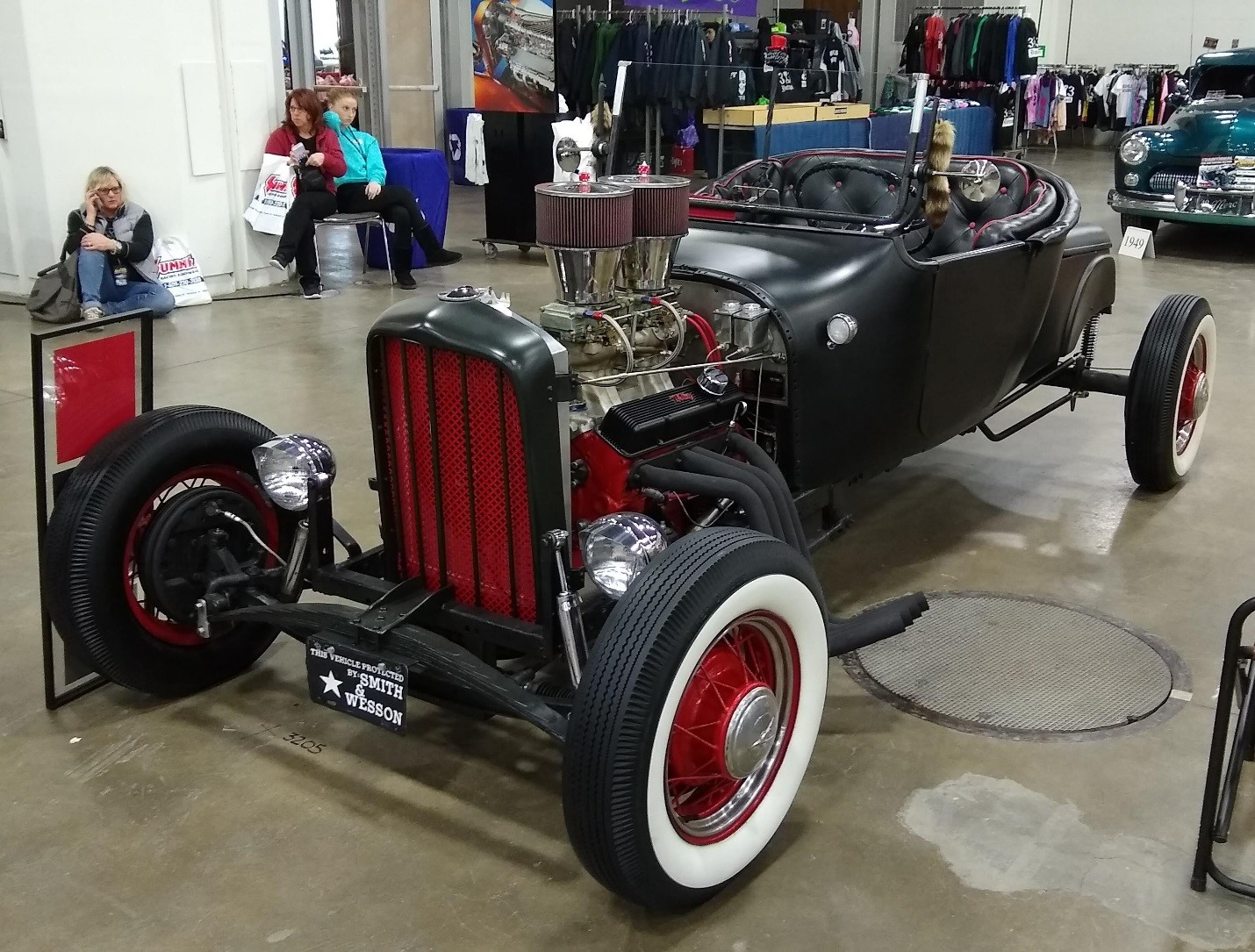 With their rambunctious reputation, John and Horace Dodge might have gotten a kick out of this rodded-up 1915 Dodge Brothers.
With their rambunctious reputation, John and Horace Dodge might have gotten a kick out of this rodded-up 1915 Dodge Brothers.
With so many cars on view, there’s something for everyone in Cobo Center. For race fans, there were slingshot dragsters and funny cars. For kids, there were go-karts and quarter midgets. For movie fans, there was a screen-used Batmobile from 1992’s Batman Returns, as well as a tribute to the late Burt Reynolds, who brought new car fans into the hobby with movies like Smokey and the Bandit, Hooper, and The Cannonball Run. And live music throughout the weekend ran the gamut from ’50s rock and roll to hard-driving R&B.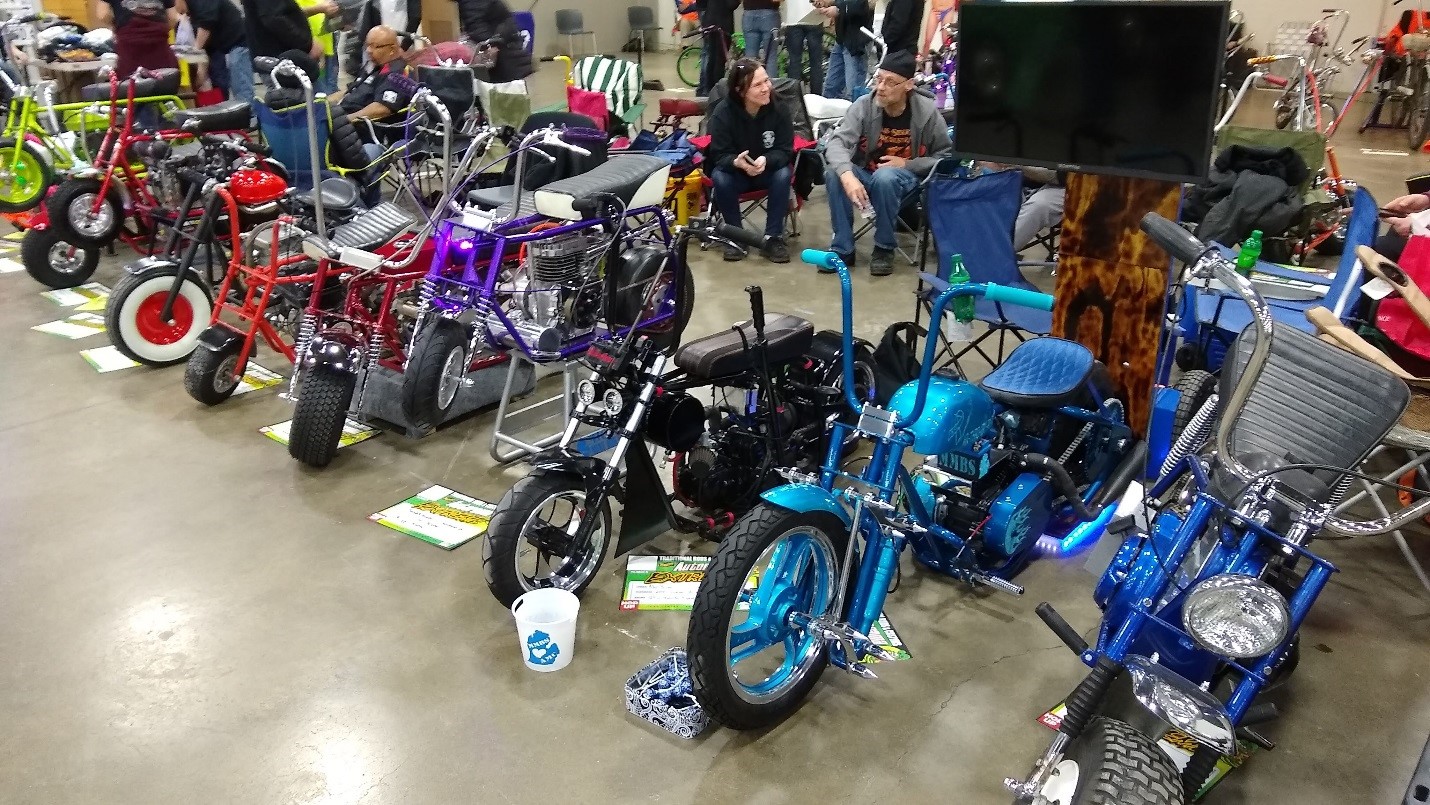 Minibikes lined up at Autorama Extreme.
Minibikes lined up at Autorama Extreme.
For all of the great cars on the main floor, Autorama veterans know that the wildest rides are found down below – at Autorama Extreme on Cobo Center’s lower level. There you’d find the rat rods, the bobber bikes, and the way-out customs that are more riddle than Ridler. There’s even an on-site chop shop where you can watch skilled fabricators at work.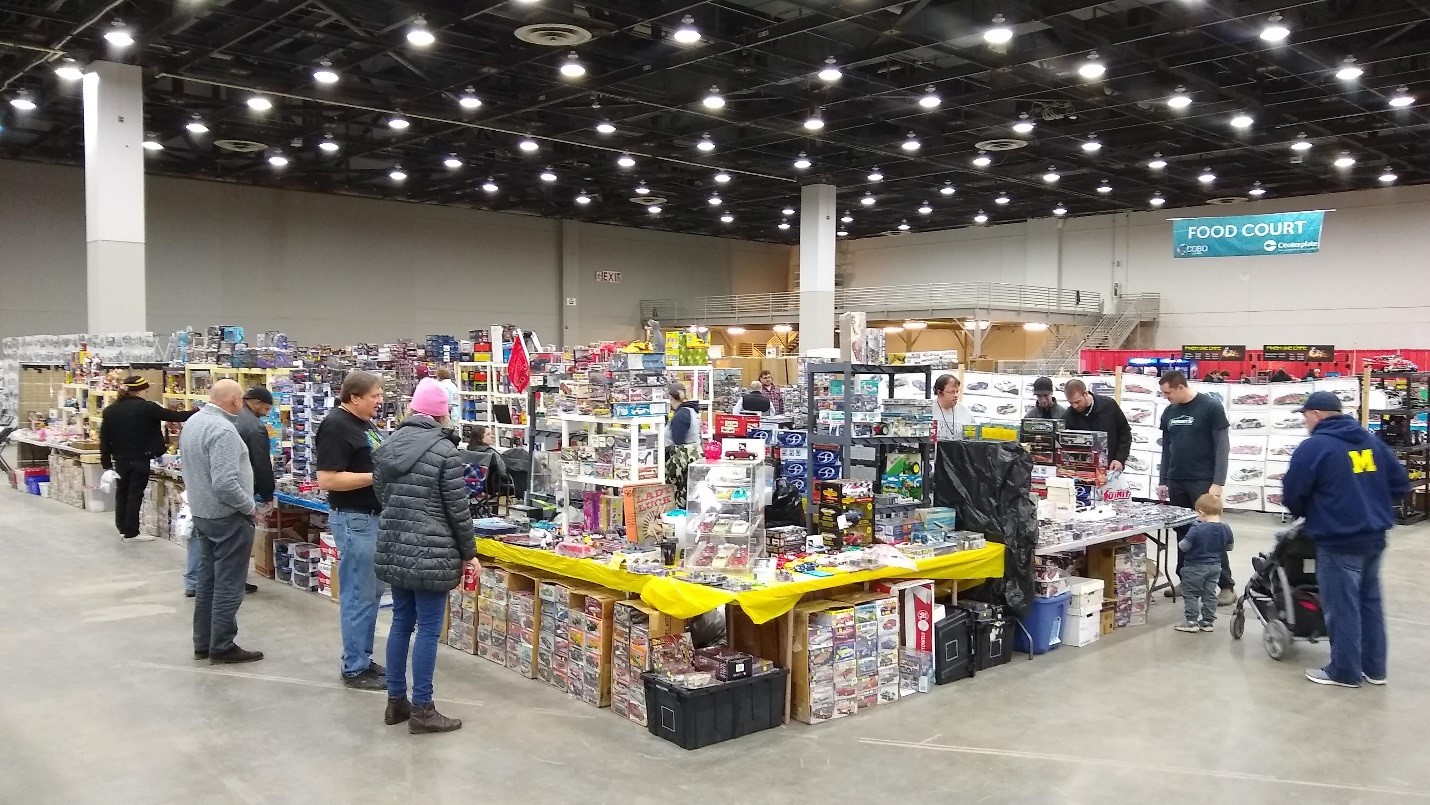 Toy-a-Rama featured vintage toys, diecast models, racing memorabilia, and automotive sales literature.
Toy-a-Rama featured vintage toys, diecast models, racing memorabilia, and automotive sales literature.
If your budget (or your garage) won’t permit you to collect full-size cars, then you could check out the Toy-a-Rama show at the back of Cobo Center. Vendors offered hundreds of diecast cars and plastic model kits, from Hot Wheels on up to beautifully-detailed 1:18 scale pieces. Other sellers offered transportation-related books and magazines, and an incredible collection of vintage automotive sales brochures and advertisements.
There’s no other show quite like it, which explains why the Detroit Autorama continues to be known among builders and fans alike as “America’s Greatest Hot Rod Show.”
Matt Anderson is Curator of Transportation at The Henry Ford.
21st century, 2010s, Michigan, Detroit, cars, car shows, by Matt Anderson, Autorama
One Last Winter
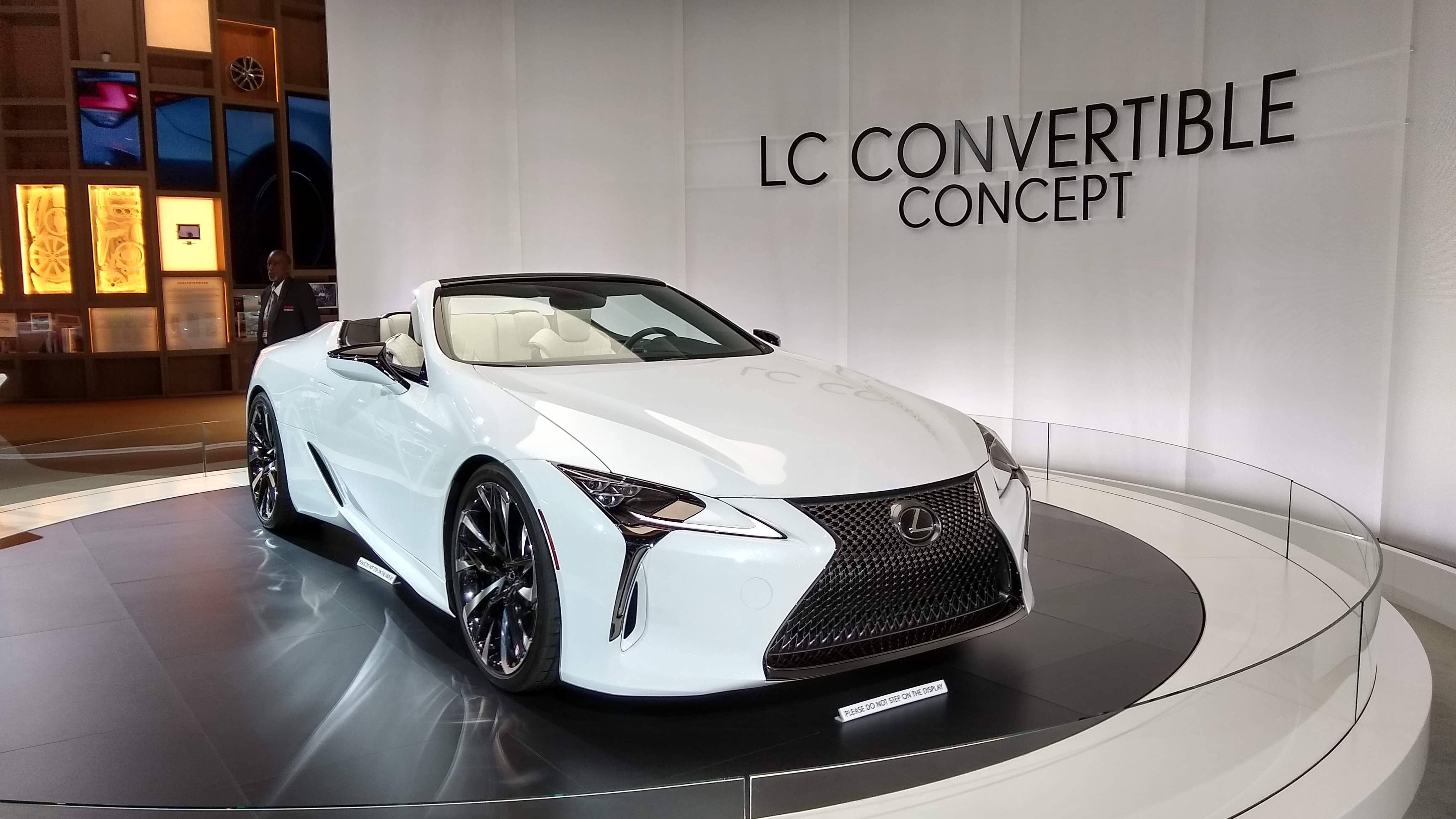 Lexus, which itself debuted at the North American International Auto Show in 1989, tantalizes visitors 30 years later with a drop-top concept version of its sporty LC coupe.
Lexus, which itself debuted at the North American International Auto Show in 1989, tantalizes visitors 30 years later with a drop-top concept version of its sporty LC coupe.A Visit to the 2019 North American International Auto Show
It’s January in Detroit which means – for one last year – it’s time for the North American International Auto Show (NAIAS). Traditionally, flashy concept cars and new production models are the talk of the town, but this year all the buzz concerns the show’s impending move to June next year. It’s a major shift – undoubtedly the biggest since the show added “International” to its title 30 years ago – but there are valid reasons. Detroit’s weather generally isn’t what you’d call “pleasant” in January; the countless people who put the show together in Cobo Center invariably find themselves working through the holiday season; and automakers are now finding themselves stretched between NAIAS and the Consumer Electronics Show, which wraps in Las Vegas just days before NAIAS opens.
It’s no secret that NAIAS – and auto shows in general – are suffering from flagging interest, both from the public and from automakers themselves. In recent years, we’ve seen a number of upmarket marques pull out of the Detroit show. (Audi, BMW and Mercedes-Benz are all conspicuous by their absence in 2019.) The move to summer might reverse this trend, too.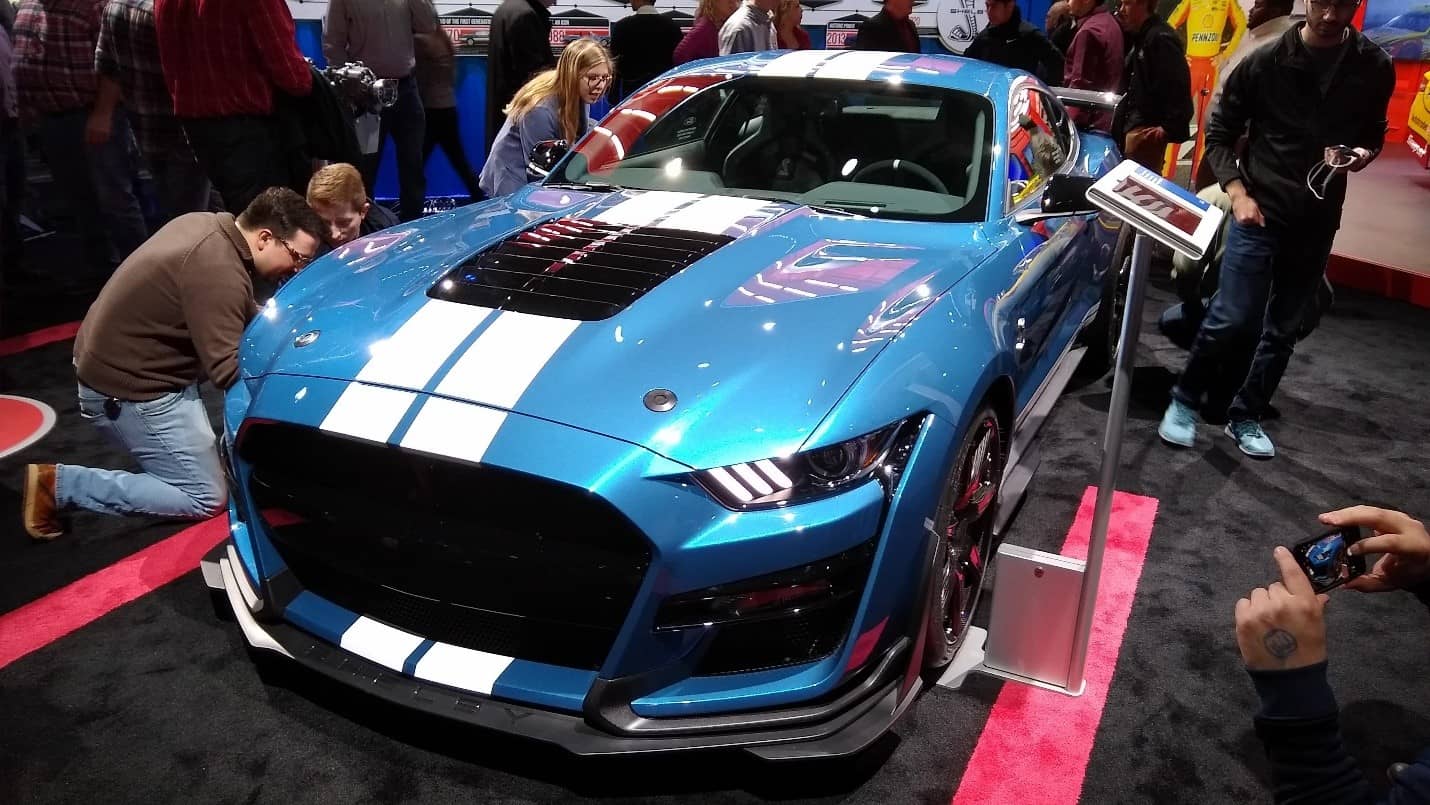
The 2020 Ford Shelby Mustang GT500 – with a menacing mug to match its hellacious horsepower.
None of this is to suggest that NAIAS is a disappointment this year. There’s still lots to see. Ford Motor Company’s trucks and SUVs are front-and-center at the Blue Oval’s booth. The reintroduced Ranger pickup gets the prime real estate, but it’s the all-new Ford Explorer getting the rave reviews from the press. My favorite, however, is the forthcoming Shelby Mustang GT500. The 700+ horsepower beast arrives for 2020 to battle the Demons and Hellcats of the world. Mr. Shelby would’ve been proud.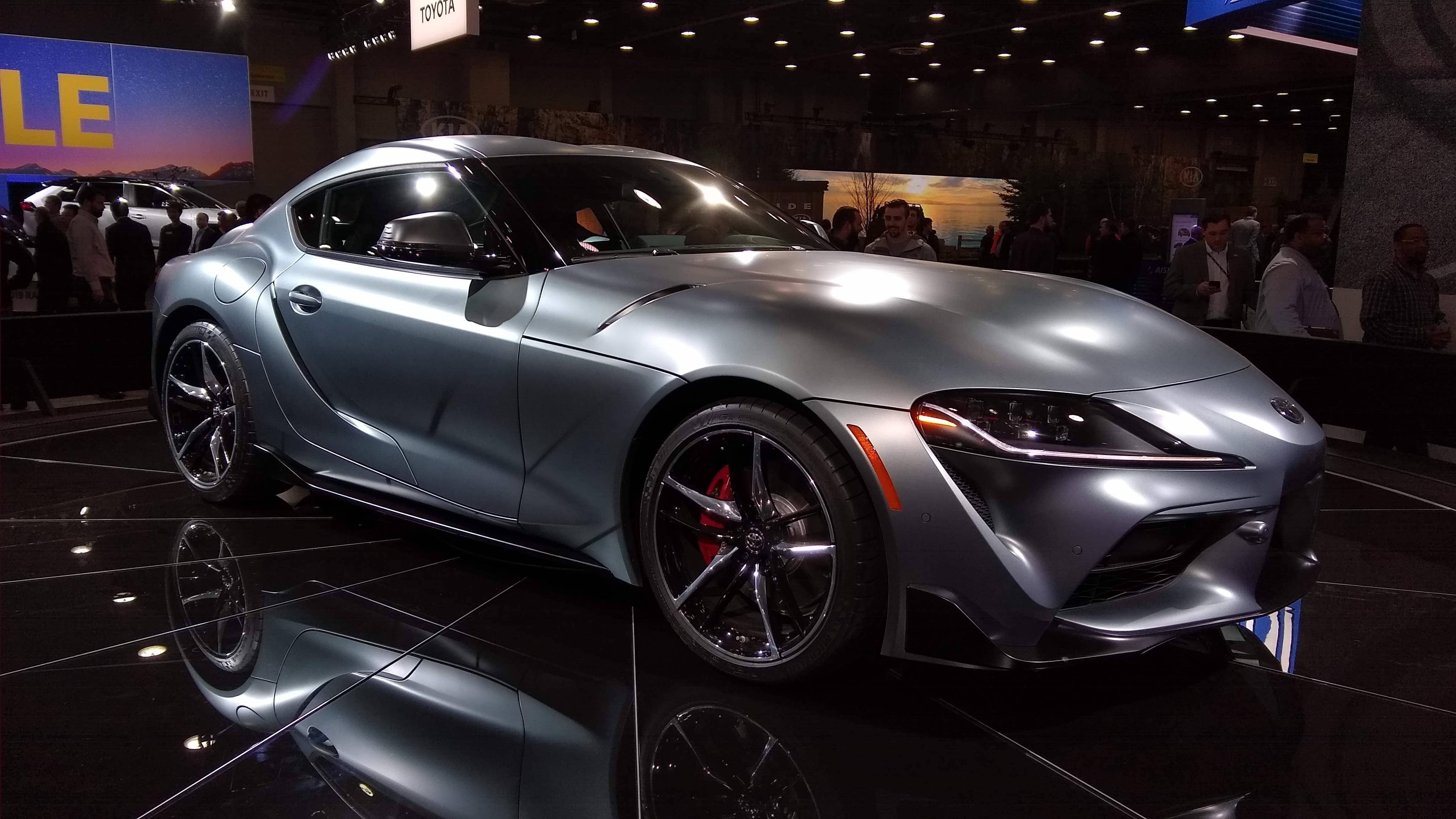
After an absence of nearly 20 years, the Toyota Supra returns for 2020.
Toyota grabs some of NAIAS’s biggest headlines with the return of its Supra sports car, not seen since the fourth generation ended production in 2002. Purists may be irked that many of the Supra’s makings – including its 3.0-liter straight-six – are of BMW lineage, but the look is all Toyota. One can even see a little 2000GT in its lines. Start saving now, as prices are expected to start just north of $50,000.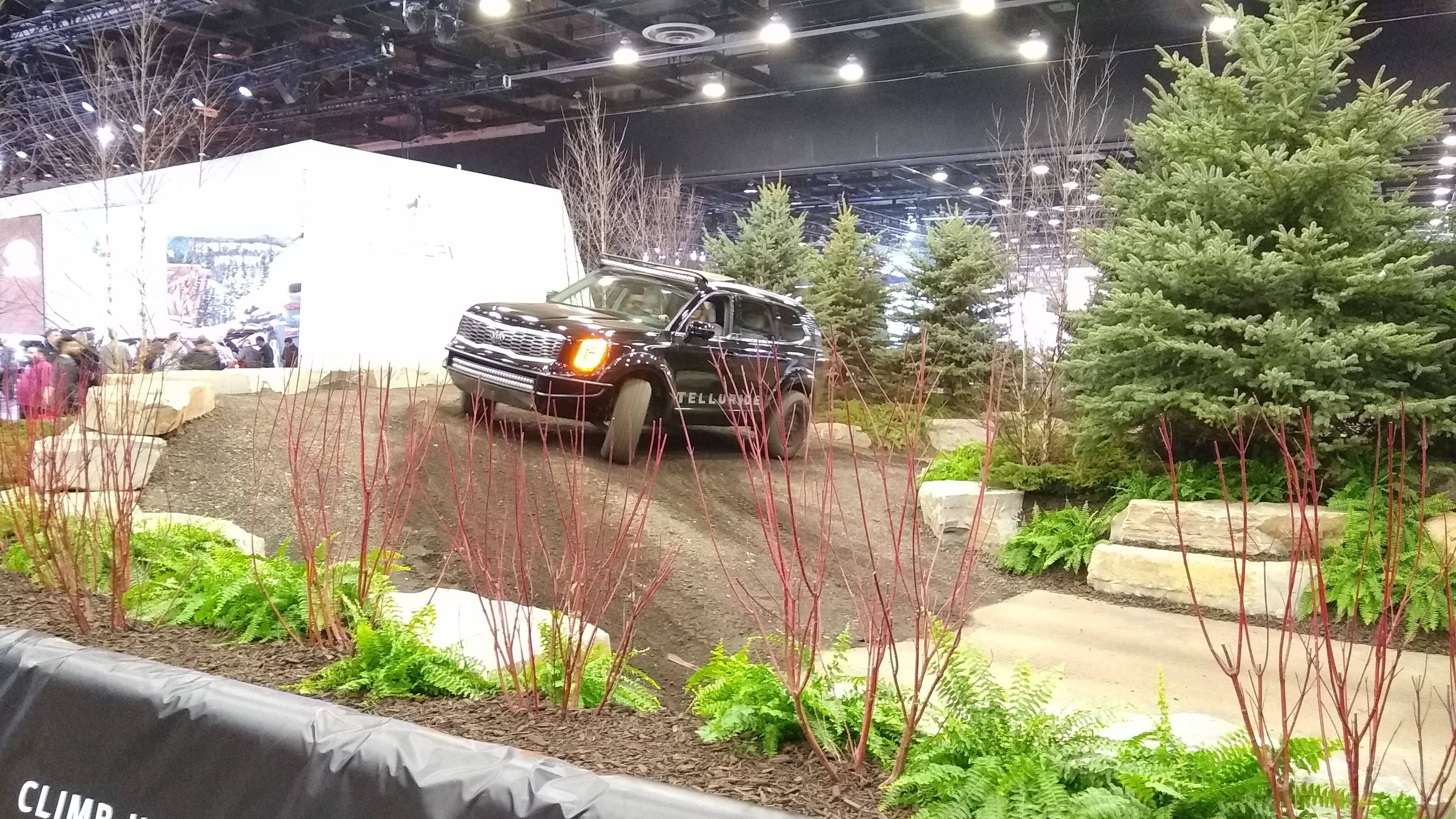
Kia’s themed test track, for its new Telluride, livens up Cobo Center’s back wall.
With gas prices low again, Americans have fallen back in love with their SUVs and crossovers. Kia answers the call with its new-for-2020 Telluride SUV, first previewed as a concept car at the 2016 NAIAS. The Telluride will be the largest vehicle in Kia’s lineup, with room for eight in its three rows of seating. Expect to see it in showrooms this May.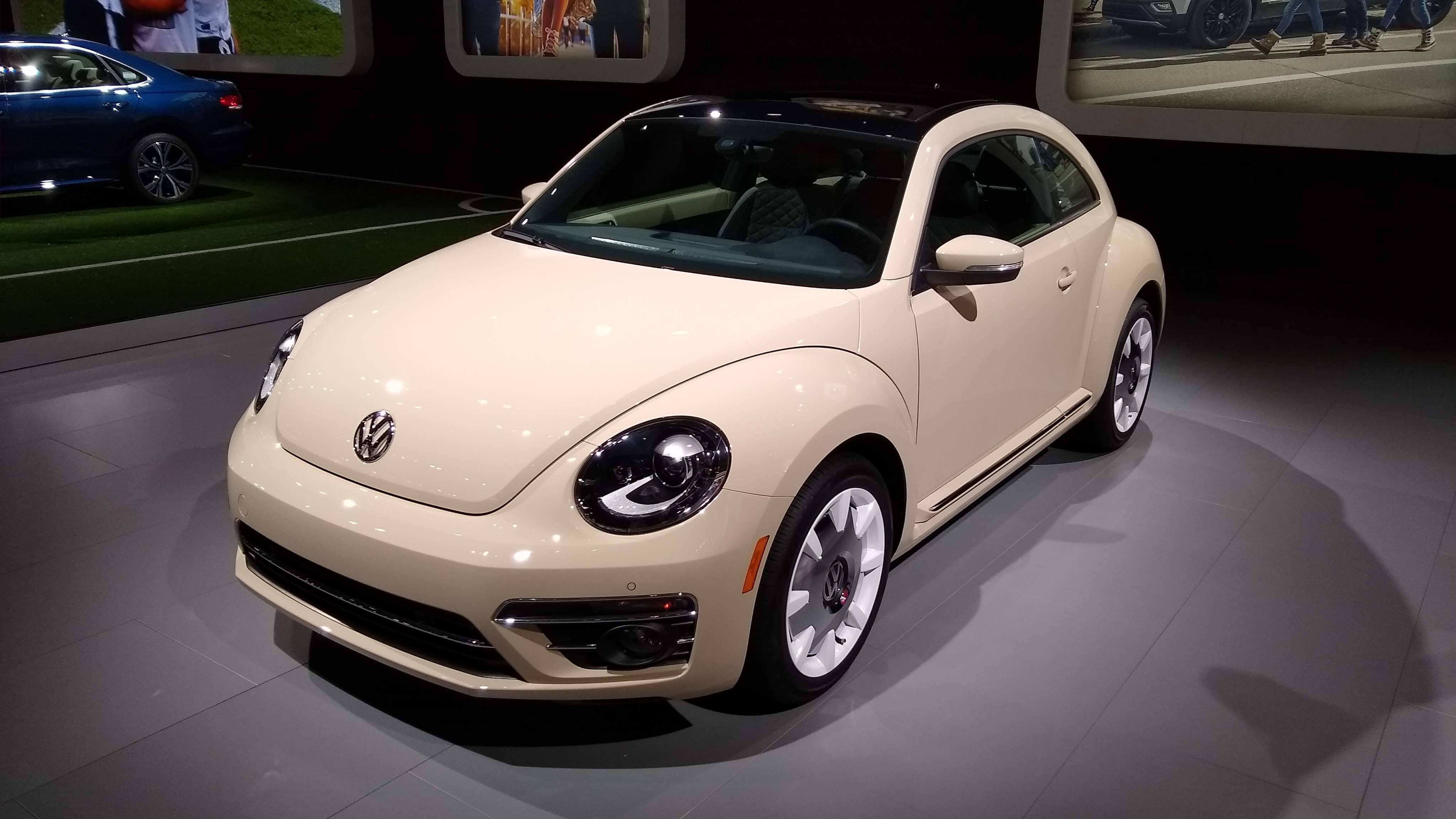
I love the pearlescent paint on this Volkswagen Beetle, though it would look even better with red, white and blue racing stripes and a big roundel on the hood.
Volkswagen has the inauspicious distinction of being the only European automaker with a major presence at NAIAS this year. True to form, though, the German marque has some of the show’s most imaginative displays. Several of its models are parked on a recreated soccer field, in celebration of VW’s sponsorship of the U.S. Soccer Federation. (Automakers have long-standing relationships with America’s pro baseball, football and basketball leagues, but VW becomes the first automotive company to serve as a presenting sponsor for U.S. Soccer.) The company’s interactives are good fun, too. Little ones will enjoy the touch screen coloring “books” that allow them to paint Beetles in any number of groovy colors – accessorized with flowers and peace symbols, of course.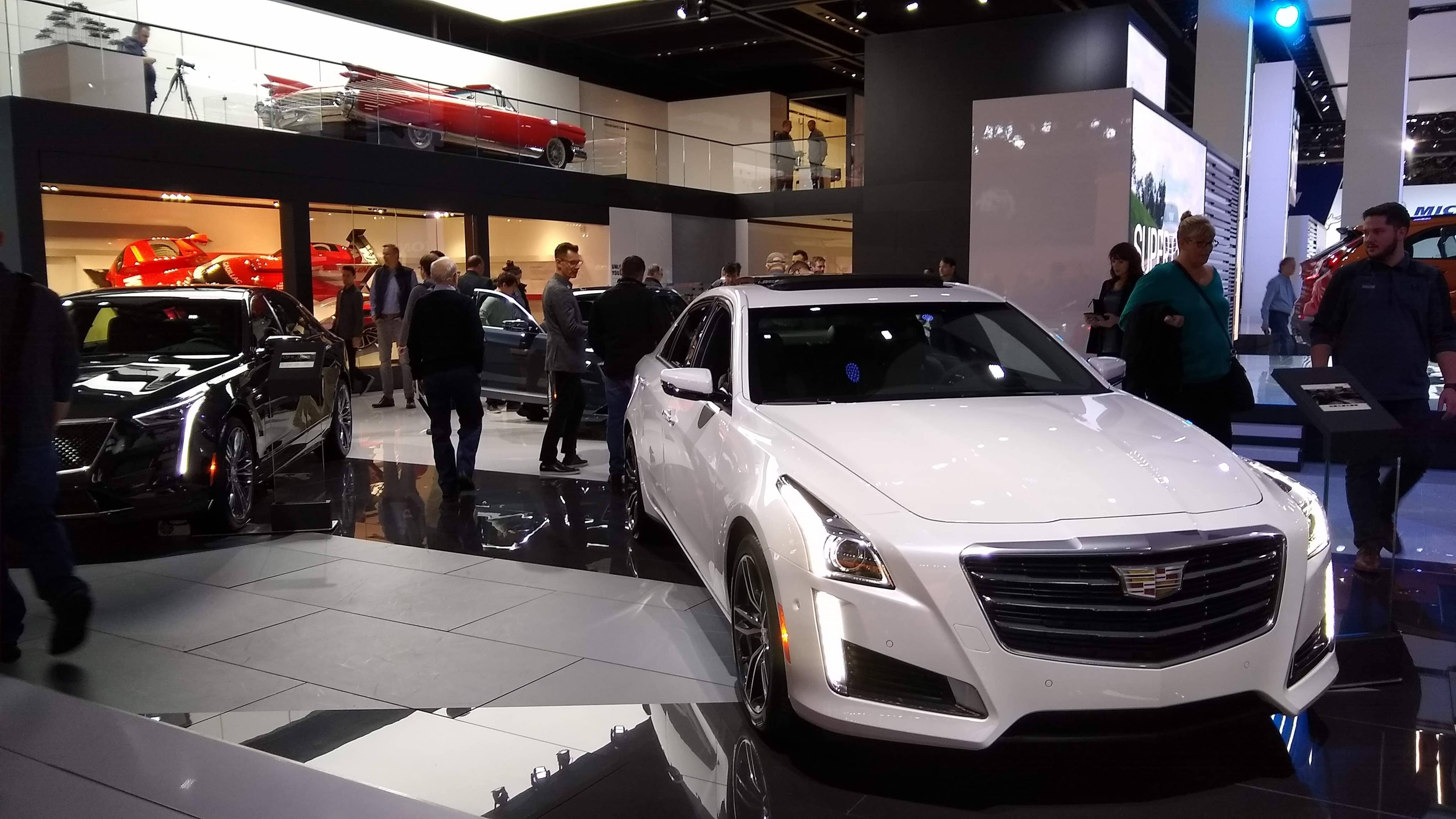
Harley Earl’s shadow hangs over Cadillac – in this case in the form of a high-finned ’59 Caddy perched above a modern CTS-V.
Sad to say, traditional three-box sedans are fading fast in Detroit. Ford and Chevrolet both have announced plans to all but end sedan production (not including specialty models like Mustang and Corvette, of course). Cadillac seems headed in that direction, too. The upmarket carmaker’s big debut this year is the 2020 XT6, a three-row SUV that might replace the full-size CT6 sedan in Cadillac’s North American lineup. The company’s ATS and CTS sedans are set to bow out this year as well.
NAIAS 2019 may feel a bit lower-key than other recent editions, but there’s still plenty to enjoy. In fact, I recommend that you spend some extra time soaking up the sights and sounds at this year’s show. After all, we’ve got a 17-month wait until the next one!
Matt Anderson is Curator of Transportation at The Henry Ford.
Michigan, 21st century, 2010s, NAIAS, Detroit, cars, car shows, by Matt Anderson
Toys That Fly!
.jpg?sfvrsn=70303f01_0)
“Mystoplane” Toy Airplane Set, 1946-1947 (2008.23.1)
“It’s scientific! It’s educational! It’s thrilling!” So claims the Mastercraft Toy Company about Mystoplane. This little airplane flies through the air without rubber bands or batteries, but with the wave of a magic wand. In reality, the Mystoplane is an extremely thin piece of foil, and the wand’s mystical power is plain old static electricity. Rub the wand against the included cloth and the resulting static charge causes the foil airplane to float near the wand’s tip. It’s low-tech fun at its best.
.jpg?sfvrsn=8c303f01_0)
P-51 Mustang Model Airplane Kit, 1970-1980 (2016.107.1)
North American Aviation’s P-51 Mustang ranked among the pre-eminent fighter airplanes in World War II. With its powerful engine and its efficient wing and fuselage design, the Mustang flew faster and farther than other Allied fighters. Mustangs escorted B-17 and B-24 bombers on raids deep into German territory. When fitted with external drop tanks to increase its fuel capacity, a Mustang could make it all the way from Britain to Berlin and back. The P-51D version, equipped with a Packard-built Rolls-Royce Merlin V-12 engine, topped out at more than 430 miles per hour. This balsa wood model doesn’t have quite the range or speed – but how much can you expect from a rubber band?
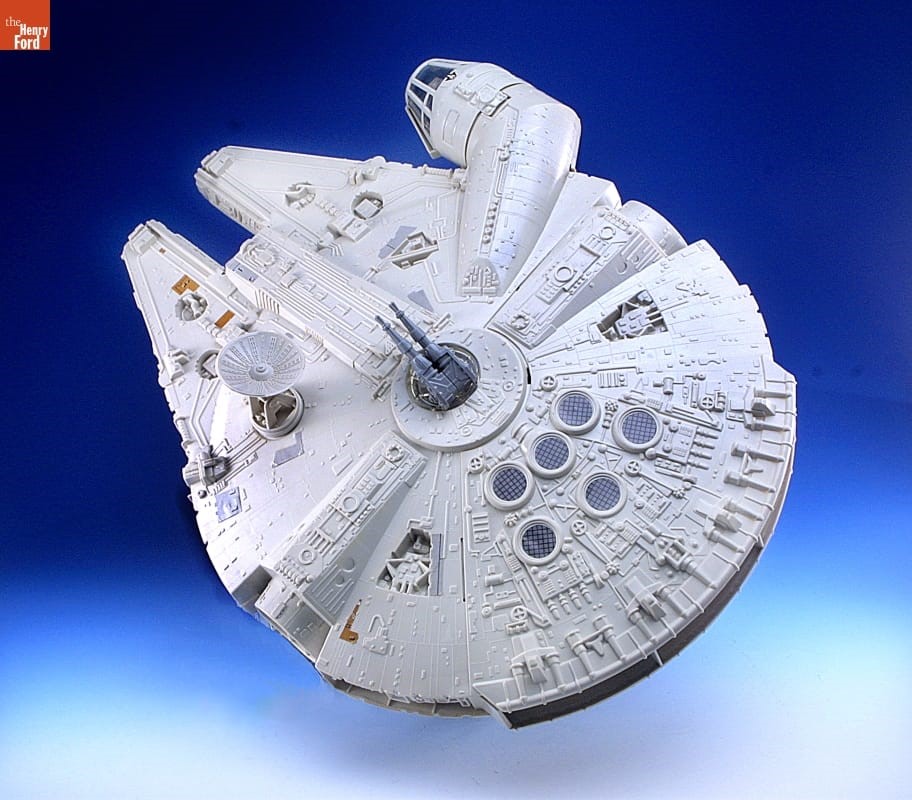
Star Wars Play Set, Millennium Falcon, circa 1979 (2002.60.7)
Part of Kenner Products’ line of action figures based on the original Star Wars films, this Millennium Falcon spaceship didn’t technically fly…but in the hands of an imaginative kid (or kid at heart), she’ll make point-five past lightspeed, carrying Han Solo and Chewbacca (sold separately) on adventures across the galaxy.
The level of detail, functionality, and compatibility with the popular 3.75” action figures made this the definitive Millennium Falcon toy for the first generation of Star Wars fans. Updated versions of the toy produced from 1995 to 2005 reused many of the original design elements. She may not look like much, but she’s got it where it counts.
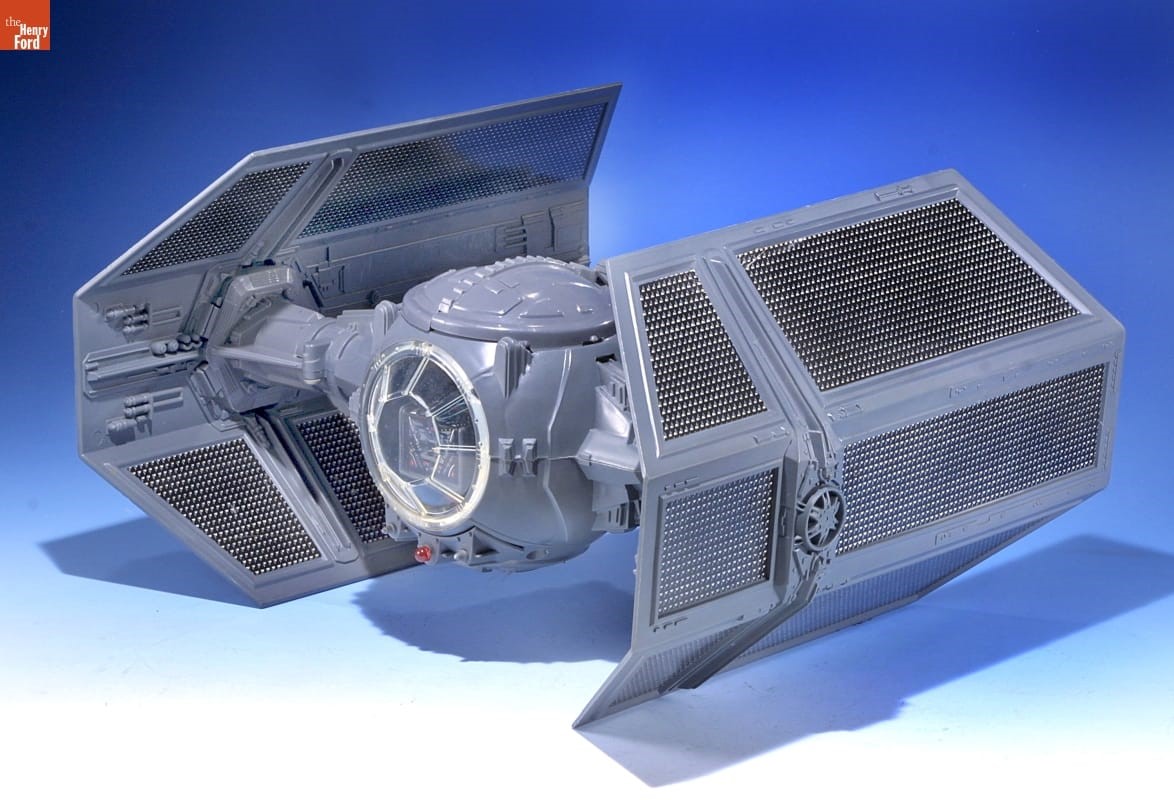
Star Wars Vehicle Play Set, Darth Vader TIE Fighter, 1979-1980 (2002.60.5)
.jpg?sfvrsn=ff303f01_0)
Spin Master “Air Hogs Hyper Stunt Drone,” 2016 (2016.114.1)
Static electricity and rubber bands were fine for the 20th century, but today’s toys are a bit more complex. This Air Hogs micro drone runs on two AAA batteries for the remote control and a USB-rechargeable battery in the drone itself. The little flyer is designed to be as user-friendly as possible, with a basic “beginner” mode and a set of shields that allow it to bounce off of obstacles. (“Crash and keep going.” If only everything in life was so simple!) Once you’ve mastered the basics, you can switch over to “advanced” mode, remove the shields, and fly as high as your confidence – and your ceiling – allows.
Never underestimate the power of play. You never know what inspiration a toy might spark – even years after the fact. You may have heard the story of the two brothers whose father brought home a rubber band-powered toy helicopter. They played and played with the little gadget and, when it broke, built versions of their own. Years later, they remembered those toys as they experimented with a new, larger project in the dunes near Kitty Hawk…
Matt Anderson is Curator of Transportation at The Henry Ford, and Jim Orr is Image Services Specialist at The Henry Ford.
President Franklin D. Roosevelt’s “Sunshine Special”
 “Sunshine Special,” the 1939 Lincoln limousine modified for official use by President Franklin D. Roosevelt, as it appeared circa 1942. (THF208669)
“Sunshine Special,” the 1939 Lincoln limousine modified for official use by President Franklin D. Roosevelt, as it appeared circa 1942. (THF208669)Editor’s Note: In connection with the exhibit Enduring Ideals: Rockwell, Roosevelt & the Four Freedoms, now showing at Henry Ford Museum of American Innovation, the following excerpt is adapted from The Sunshine Special: FDR’s 1939 Lincoln K Series Presidential Limousine by Brody Levesque. The complete book is available at the Benson Ford Research Center.
A Unique Car Built Expressly for a President
One of the first things that a visitor notices when viewing the presidential vehicles at Henry Ford Museum of American Innovation is the size of the 1939 Lincoln K Model limousine custom built for President Franklin D. Roosevelt. The car is massive. In fact, it weighs in at over 9,300 pounds and has an impressive wheelbase of 160 inches.
In 1937, Ford Motor Company president Edsel Ford lobbied to obtain a government contract to provide a presidential limousine for FDR’s use. He wanted to regain a presence in the White House Garage and particularly to have Ford Motor Company’s prestige Lincoln division as the primary choice for presidential conveyance. Edsel Ford also knew that FDR liked his company’s cars.
Roosevelt, who was beginning the second of his four presidential terms, personally owned a 1938 Ford V-8 convertible coupe for his use at The Little White House in Warm Springs, Georgia, along with a 1936 Ford V-8 Phaeton convertible at his home in Hyde Park, New York. Both cars were equipped with special hand-operated controls so that FDR, whose paralytic illness prevented the use of his legs, could drive the cars himself.
Ford Motor Company’s Lincoln division delivered, in November 1939 and at a cost of $8,348.74, a current model K series chassis, to the Buffalo, New York, coachworks firm of Brunn & Company. There the four-door convertible, equipped with a 150-horsepower 414-cubic inch V-12, was further modified to meet U.S. Secret Service requirements. Brunn’s modifications added another $4,950 to the limo’s total cost.
The car was built with forward-facing jump seats, wider opening rear doors, reinforced extra-depth running boards and a pair of step plates above the rear bumper. It had strategically-placed handles for the Secret Service agents, as well as a Federal Electric Company police red light and siren combination with dual driving lamps and flag staff holders on the front. Another feature was that the roof was made extra tall so that the President, who had limited mobility and used a wheelchair, could enter and exit the car without difficulty.
Although coachbuilder Herman A. Brunn, owner of Brunn & Company, thought the car looked terrible with that extra tall top, the limo was finished and sent to Washington as ordered. In the end, it seems Mr. Brunn was right. According to Ford Motor Company internal memoranda and telegram communications, the car was returned to Brunn & Company’s Buffalo plant in the summer of 1941 to have its top replaced with one of standard height. Global events forced even more significant changes to the limo that December.
 President Roosevelt preferred open cars whenever the weather permitted – and sometimes when it didn’t. (THF208655)
President Roosevelt preferred open cars whenever the weather permitted – and sometimes when it didn’t. (THF208655)
The First Presidential Car to Acquire Its Own Personality
Within a few weeks after the December 7, 1941, attack on Pearl Harbor, the White House Garage delivered the 1939 Lincoln K series limousine to Ford Motor Company’s plant in Alexandria, Virginia, on the waterfront across the Potomac River from Washington D.C. The car was shipped to the Lincoln plant on West Warren Avenue in Detroit and, upon its arrival, Lincoln workers began to disassemble the limousine, readying its wartime armor and additional modifications requested by the Secret Service.
Workers removed the Brunn body and altered the car’s chassis. Its suspension was beefed up with heavy-duty shock absorbers and additional leaves in the springs – to handle the added weight of armor plating and thick bullet-resistant glass. Likewise, a modified windshield frame was installed to accommodate the thicker windshield glass. When the Brunn body was reinstalled, it received a new 1942 model H series Lincoln front end clip (fenders, grill, and front nose cap piece), which gave the car a crisp, more modern look.
A more powerful generator was installed, with new wiring harnesses. Cooling was improved by making the radiator tank top an inch thicker, adding three-and-one-half inches more to the core than was standard, and a larger fan was put in for additional engine cooling capacity. The cowling also had wider side vents installed to let more of the engine’s heat escape.
The whitewall bias-ply tires were replaced with the first generation of what are now referred to as “run flat tires,” which enabled the big limousine to continue to travel a short distance to safety if the tires were shot out. The two spare tires were put into reworked special front fender wells, in painted metal tire covers that didn’t need to be bolted into place and allowed for rapid tire changes.
Other body modifications included one-and-one-eighth inch thick nine-ply glass; a special rear-mounted antenna for radio equipment; and steel plating in the doors, firewall, kick and quarter panels, floor, transmission hump, and gas tank. The doors received three-sixteenths inch steel armor plating. Including the weight of the armor and the bullet-resistant glass, each modified door weighed almost 200 pounds. Stronger latches and striker plates were installed to handle the heavier door weight.
A bullet-resistant divider was installed between the front and rear seats. It included fold out bullet-resistant side glass screens for use when the convertible top was down. Another bullet-resistant screen could be added behind the rear seat when the top was lowered, and then stored in the trunk when not in use. When the door windows were down, a spring-loaded flap covered the slot in the top of the door to stop things from falling inside and jamming the windows.
When the Lincoln originally was delivered in 1940, it was painted a dark midnight blue with russet trim. Now the car was repainted in black, with chrome trim and brightwork. The rear step plates, grab handles, and wider running boards were reinstalled after the repainting was finished.
Detroit plant workers also added new running/fog lights to the front bumper, along with flag staff holders. The Federal Electric Company police red light and siren were reinstalled on the left front fender. By the end of the second week of April 1942, the car was ready to ship back to the Alexandria plant for delivery to the White House Garage where it could resume its presidential duties.
At an unknown time after the car’s 1942 retrofitting, an unidentified member of the White House Press Corps gave the limo the sobriquet it retains today: “Sunshine Special.” Although the exact reason for the nickname is lost to history, it may have been due to FDR’s well-known love of riding with the top down – sometimes even when the weather recommended against it.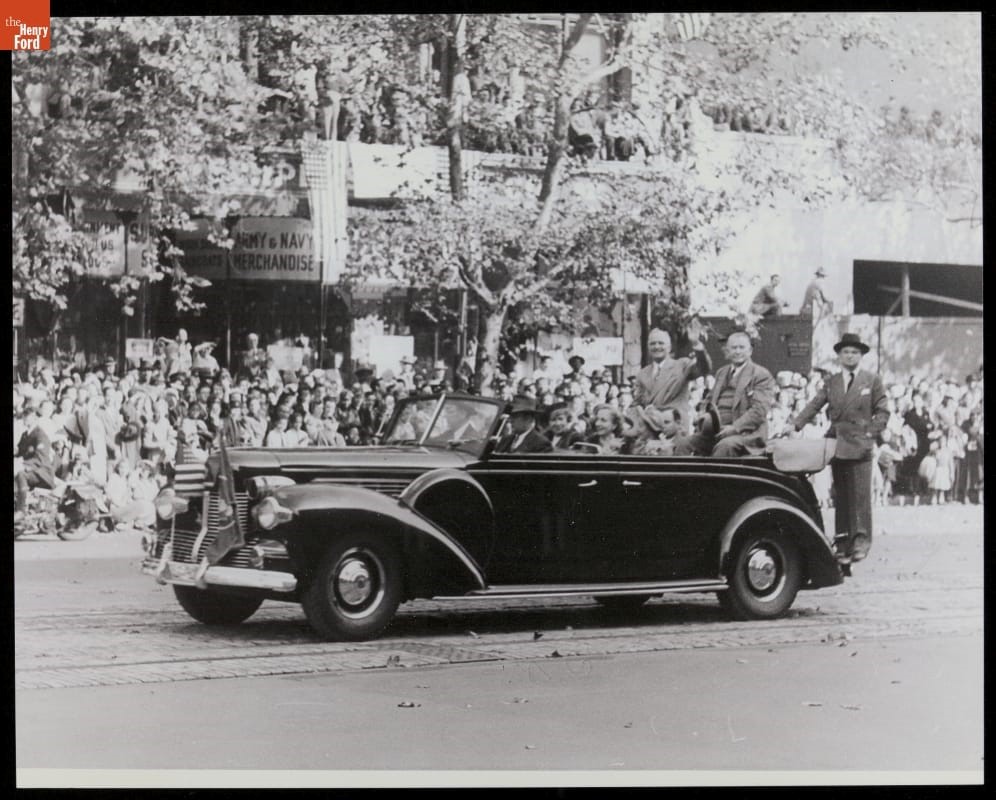
President Harry S. Truman aboard “Sunshine Special” near the end of the car’s service life, circa 1949. (THF208667)
Following FDR’s death on April 12, 1945, “Sunshine Special” served his successor, Harry S. Truman, for another five years. The White House put out bids for a new presidential limousine in the spring of 1949 and, that summer, officials met with representatives from Ford Motor Company to discuss the contract. This would be the largest single order ever placed for the White House fleet.
In the early summer of 1950, nine custom-built enclosed 1950 model Lincoln Cosmopolitan limousines, produced by the Henney Motor Company of Freeport, Illinois, were delivered to the White House Garage. A matching four-door Lincoln Cosmopolitan convertible-bodied limousine, modified at the Grand Rapids, Michigan, shop of master coachbuilder Raymond Dietrich, was also delivered. The Dietrich seven-passenger Lincoln was fitted with a Hydramatic automatic transmission purchased from General Motors and then modified to mate with the 337 cubic-inch V-8 engine. Per the order’s specifications, none of the limousines were armored.
Upon delivery of the fleet of Lincoln Cosmopolitan limousines, older White House Garage vehicles were shipped back to their manufacturers or sold off. “Sunshine Special” was returned to Lincoln and subsequently donated to The Henry Ford.
Adapted from The Sunshine Special: FDR’s 1939 Lincoln K Series Presidential Limousine by Brody Levesque. The complete book is available at the Benson Ford Research Center.
Matt Anderson is Curator of Transportation at The Henry Ford.
Additional Readings:
- 1939 Lincoln Presidential Limousine Used by Franklin D. Roosevelt
- Innovation Icon: Kennedy Presidential Limousine
- Protecting Our Presidents
- 1912 Baker Electric Victoria: Transportation for Five First Ladies
Washington DC, 20th century, 1940s, 1930s, presidents, presidential vehicles, limousines, Henry Ford Museum, Ford Motor Company, cars, by Matt Anderson, books

